Explore the 10 best Tealium alternatives for 2025—compare CDP and martech platforms on features, pricing, and use cases to find your perfect fit.
Tealium Alternatives 2025
Choosing a marketing platform shouldn’t be about compromise. This guide cuts through the noise to present 10 Tealium alternatives for 2025, focusing on what each does best. Discover options that align with your priorities—whether that’s advanced personalization, channel integration, or implementation speed.
Content:
A Tealium Overview
Tealium is a pioneer in the customer data platform (CDP) space, known for its Customer Data Hub consisting of several products.
Tealium iQ Tag Management helps manage website and app tags in one place (reducing the need for manual code changes).
Tealium AudienceStream CDP is a server-side platform for identity resolution, visitor data enrichment, customer segmentation, and real-time integrations. Together, these tools unify data from web, mobile, and other sources into comprehensive profiles that update in real time.
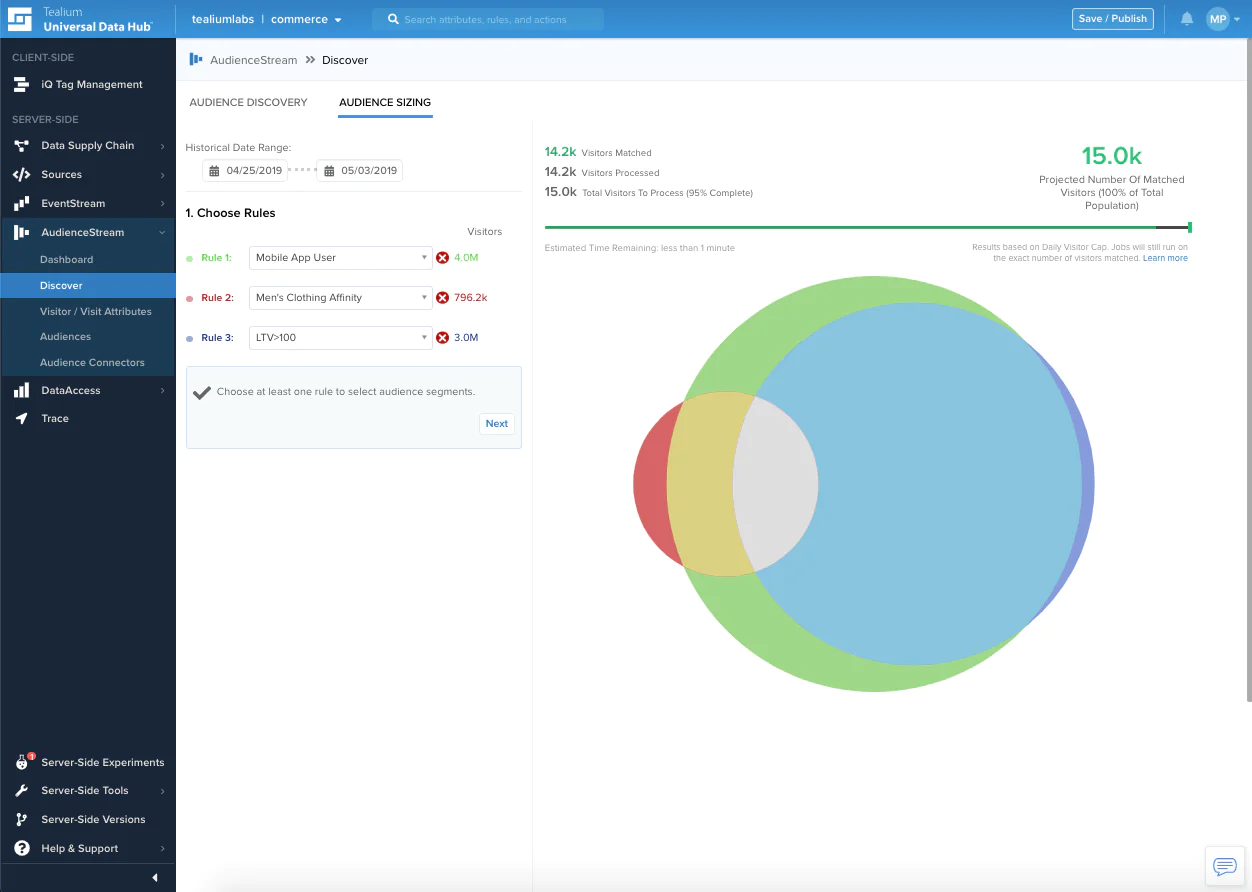
Audience analysis in Tealium
Tealium also offers an API hub (EventStream) for server-side data collection and Connectors to activate audiences by sending data to hundreds of marketing tools.
Additionally, Tealium provides built-in compliance features for consent management and a Predict ML add-on for predictive insights. In short, Tealium’s value is in centralizing customer data (from tags and APIs) and orchestrating audiences to downstream marketing and analytics platforms.
Strengths
- Robust Data Unification: Tealium excels at consolidating data from disparate sources. Companies can feed in behavioral data (web events, mobile usage, offline transactions) and Tealium will stitch together profiles using identity resolution. This cross-channel intelligence helps brands see a single customer journey rather than fragmented touchpoints.
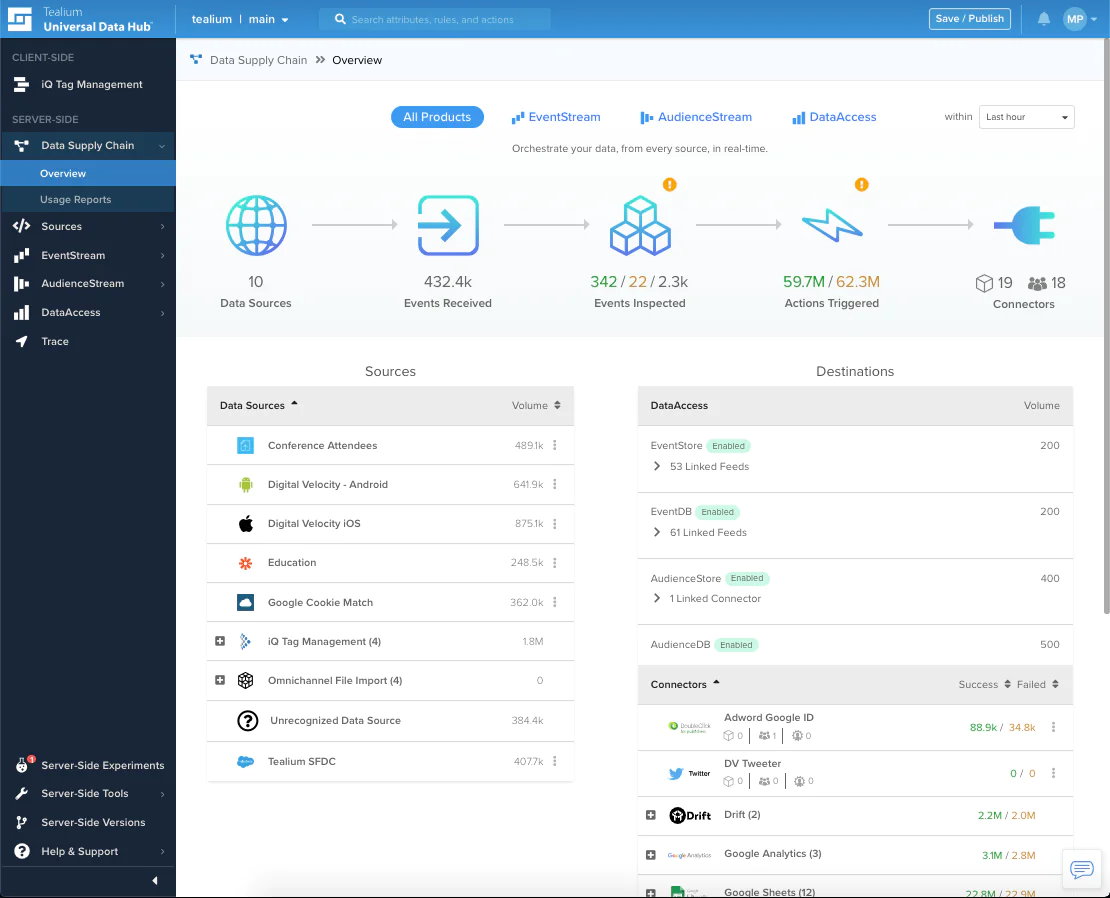
Data sources overview in Tealium
- Real-Time Segmentation: With AudienceStream, Tealium allows you to define audiences based on behaviors and attributes, and update those segments in real time as new data flows in. For example, a user moving from “browser” to “cart abandoner” segment can trigger immediate follow-up actions.
- Extensive Integrations: Tealium has 1,300+ vendor integrations (tag and connector templates) enabling data to flow into ad networks, email service providers, analytics suites, and more. This makes it a versatile hub: collect data once, and syndicate everywhere.

Tealium’s audience connectors
- Enterprise-Grade Compliance: Tealium includes governance tools for data privacy (Consent Management module) and enforces strict security. Global enterprises appreciate features like consent tracking and GDPR/CCPA compliance built into the platform.
Pain Points with Tealium
Despite its power, Tealium isn’t without drawbacks.
Cost and Pricing Model
Tealium’s pricing is firmly in enterprise territory. It typically requires an annual contract and pricing is based on factors like event volume, number of profiles, and required modules. In practice, brands often spend five to six figures per year on Tealium. Smaller teams or mid-market companies can find this cost hard to justify. Unlike some competitors, there’s no free tier—even testing often requires a paid plan. As needs scale (more visitors, more integrations), costs increase. For budget-conscious companies, Tealium can feel like an “enterprise-only” solution.
Technical Overhead
Implementing and maintaining Tealium can be complex. While it offers flexibility, non-technical users often need developer support to set up custom tracking or adjust tag configurations.
Similarly, fully leveraging AudienceStream’s capabilities might involve setting up data feeds, writing enrichment rules, and ensuring your data schema is consistent. This steep learning curve means time-to-value isn’t instantaneous—your team may spend weeks or months configuring Tealium before seeing results.
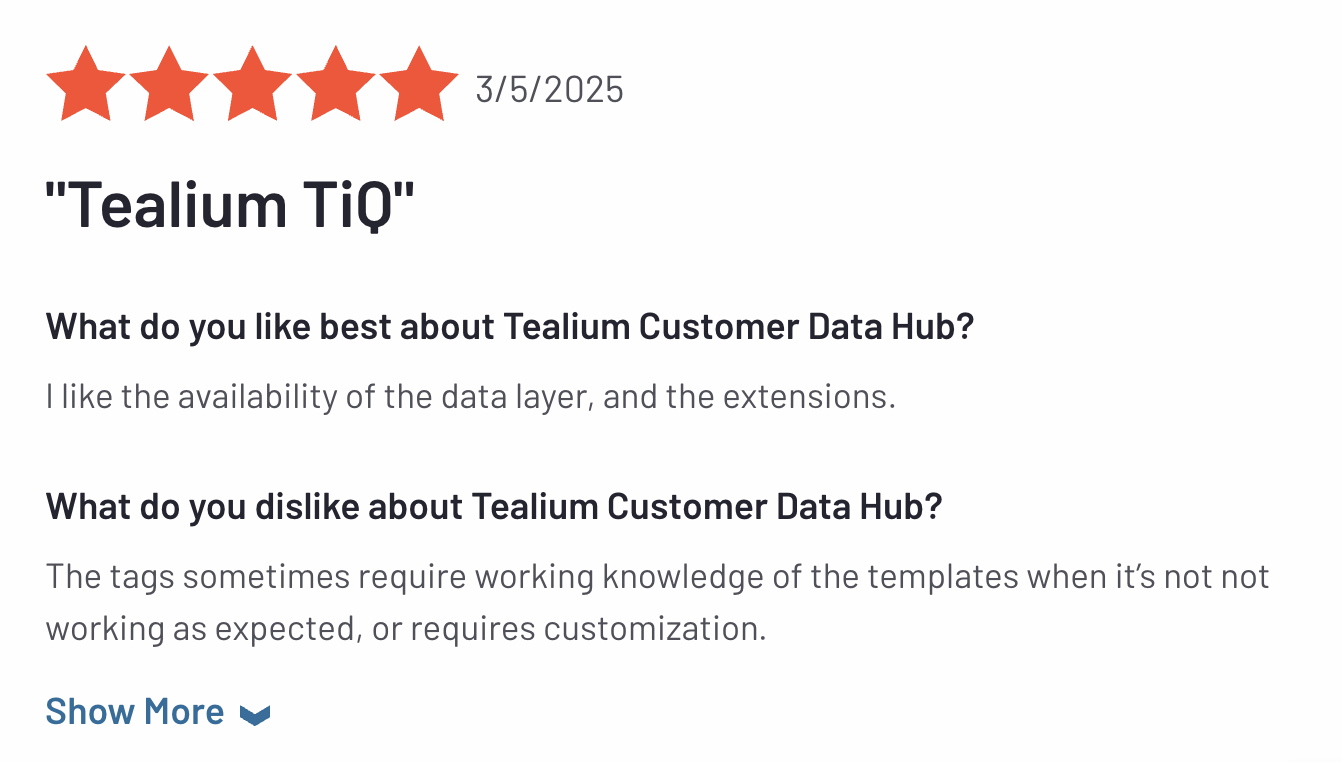
For companies without dedicated analytics or developer teams, this complexity can be overwhelming.
Limited Campaign Execution
Tealium is data-first and intentionally channel-agnostic—it sends segments to other tools but doesn’t execute campaigns itself. That means you’ll still need separate systems for email marketing, personalization, advertising, etc. With Tealium, you might end up juggling a marketing automation platform, an email service, an ad platform, and Tealium as the data pipe between them.
This “hub-and-spoke” model works, but the patchwork of tools can introduce delays and integration challenges. Brands seeking a one-stop platform for both data and omnichannel campaigning might find Tealium’s scope limited.
Slow Adapters to Data Warehouse Ecosystem
As the analytics world evolves, many companies are adopting a “composable CDP” approach—leveraging their data warehouse (e.g., Snowflake, BigQuery) as the source of truth and using lighter tools to sync data out (reverse ETL). Tealium’s model, however, stores and processes data within its own system. It offers data export, but it’s not a warehouse-native solution. With Tealium, you are somewhat locked into its ecosystem (though robust) for profile storage and processing.
In summary, Tealium is a powerful CDP for enterprises—but its cost, complexity, and need for complementary tools mean it’s not the perfect fit for everyone. As your company grows or your strategy shifts, you might wonder if there’s a better way to manage customer data and engagement.
The Alternatives at a Glance
Best For
Key Features
Price Range
Maestra
Full-funnel marketing for ambitious e-commerce brands
Full-funnel marketing for ambitious e-commerce brands
• Real-time CDP for behavior-driven segmentation
• Hyper-personalized omnichannel flows
• Built-in loyalty program and promotions engine
• Real-time site personalization
• Dedicated Customer Success Manager
• Hyper-personalized omnichannel flows
• Built-in loyalty program and promotions engine
• Real-time site personalization
• Dedicated Customer Success Manager
From $2,990/month
Twilio Segment
Developer-friendly data integration and routing
Developer-friendly data integration and routing
• 300 connectors for collecting and sending data
• Real-time event streaming & custom Functions for transformation
• Supports major data warehouses (Redshift, BigQuery, Snowflake) for storage
• Strong data governance and tracking plan tools
• Real-time event streaming & custom Functions for transformation
• Supports major data warehouses (Redshift, BigQuery, Snowflake) for storage
• Strong data governance and tracking plan tools
Free (1,000 MTUs) to $120/month (10k MTUs) for Team; enterprise custom
Treasure
Data Scalable CDP with big data & AI analytics
Data Scalable CDP with big data & AI analytics
• Enterprise data ingestion & enrichment at scale
• Advanced analytics and AI for customer insights
• Cross-channel audience activation via many integrations
• Emphasis on security and compliance (privacy by design)
• Advanced analytics and AI for customer insights
• Cross-channel audience activation via many integrations
• Emphasis on security and compliance (privacy by design)
Custom pricing (typically enterprise-tier)
Salesforce Data Cloud
Salesforce-centric real-time customer profiles
Salesforce-centric real-time customer profiles
• Natively unifies data across Salesforce CRM, Marketing, Commerce tools
• Real-time profile updates and segment triggers in Salesforce ecosystem
• Einstein AI for predictive scoring and personalization
• Pre-built connectors for Salesforce apps (Sales, Service, Marketing)
• Real-time profile updates and segment triggers in Salesforce ecosystem
• Einstein AI for predictive scoring and personalization
• Pre-built connectors for Salesforce apps (Sales, Service, Marketing)
Custom pricing (Add-on for Salesforce; enterprise-level)
Adobe Real-Time CDP
Enterprise CDP for Adobe Experience Cloud
Enterprise CDP for Adobe Experience Cloud
• Collects and unifies B2C & B2B data into real-time profiles ready for activation
• End-to-end audience management and journey orchestration across channels
• Native integration with Adobe tools (Analytics, Target, Campaign, etc.)
• Identity resolution and data governance at scale
• End-to-end audience management and journey orchestration across channels
• Native integration with Adobe tools (Analytics, Target, Campaign, etc.)
• Identity resolution and data governance at scale
Custom pricing (enterprise plans via Adobe)
Particle
Mobile-first customer data orchestration
Mobile-first customer data orchestration
• Comprehensive data infrastructure with 300 integrations (apps, feeds, APIs)
• Real-time data collection, user profiles, and audience syncing
• Privacy and consent management, built-in data quality tools
• Scalable architecture for high-volume mobile and web data
• Real-time data collection, user profiles, and audience syncing
• Privacy and consent management, built-in data quality tools
• Scalable architecture for high-volume mobile and web data
Custom pricing (usage-based; starts ~ $1K+/month for growth tier)
Bloomreach Engagement
Commerce-focused marketing automation & CDP
Commerce-focused marketing automation & CDP
• AI-driven product discovery and personalized site search
• Integrated content management and merchandising tools
• Omnichannel campaign execution (email, SMS, push, ads)
• Revenue and funnel analytics tailored to e-commerce
• Integrated content management and merchandising tools
• Omnichannel campaign execution (email, SMS, push, ads)
• Revenue and funnel analytics tailored to e-commerce
From ~$4,000/month (mid-market plans; enterprise custom)
Insider
AI-driven omnichannel personalization for enterprises
AI-driven omnichannel personalization for enterprises
• AI-powered segmentation & recommendations (predict purchase, churn, etc.)
• Personalization across 12 channels (web, app, email, WhatsApp, Instagram)
• Unique content formats like Instagram-like web stories (InStory)
• Journey orchestration with intuitive visual campaign builder
• Personalization across 12 channels (web, app, email, WhatsApp, Instagram)
• Unique content formats like Instagram-like web stories (InStory)
• Journey orchestration with intuitive visual campaign builder
Custom pricing (enterprise; no free tier)
ActionIQ
Composable CDP for advanced segmentation
Composable CDP for advanced segmentation
• Data-agnostic architecture—connects to data lakes/warehouses easily
• Intuitive UI for marketers to explore data and build audiences
• Deep audience analytics and cohort creation tools
• Strong data governance, privacy controls and compliance
• Intuitive UI for marketers to explore data and build audiences
• Deep audience analytics and cohort creation tools
• Strong data governance, privacy controls and compliance
Custom pricing (enterprise; tailored quotes)
BlueConic
Marketer-friendly unified customer profiles
Marketer-friendly unified customer profiles
• Real-time unified customer profiles with progressive data capture
• Predictive segmentation and machine learning insights for targeting
• Easy-to-use interface for marketers to deploy personalization quickly
• Pre-built connectors to email, CRM, e-commerce and ad platforms
• Predictive segmentation and machine learning insights for targeting
• Easy-to-use interface for marketers to deploy personalization quickly
• Pre-built connectors to email, CRM, e-commerce and ad platforms
Custom pricing (based on volume of profiles and modules)
Tool #1: Maestra
Best Tealium alternative for comprehensive e-commerce marketing
Maestra is an all-in-one omnichannel marketing platform built for brands ready to leave the patchwork approach behind. It combines a real-time CDP, multi-channel marketing automation, and loyalty tools in one solution. With Maestra, you’re not just unifying customer data—you’re immediately putting it to work through personalized campaigns across email, SMS, web, and more.

Maestra: user segmentation
For ambitious e-commerce companies especially, Maestra offers a path to execute data-driven marketing without juggling multiple vendors. It’s the Tealium alternative that doesn’t just collect data; it helps you act on it in real time.
Key Features:
- Real-time CDP and segmentation: Maestra ingests customer events and updates profiles instantly. Behavior-based attributes update in real time, enabling on-the-fly audience building.
- Email, SMS, and push marketing built-in: Through a drag-and-drop visual builder, marketers design automated flows that reach customers via email, text, push notifications, and more—all natively within Maestra. No need to export segments to a separate ESP (as you would with Tealium); Maestra can send the message at the right moment.
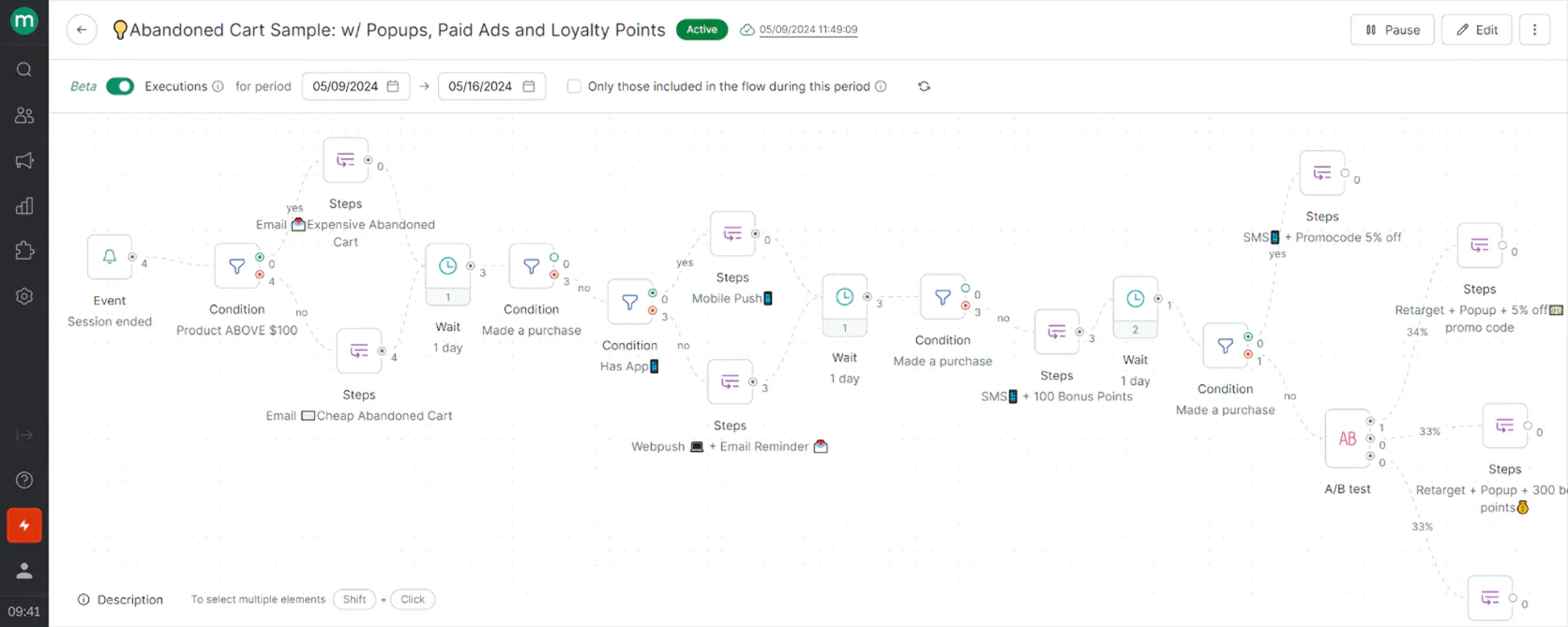
Maestra’s flow example: abandoned card flow with emails, mobile and web pushes, pop-ups, paid ads and loyalty points
- Real-time site personalization: Maestra can personalize on-site content and offers for each visitor. For example, show product recommendations, dynamic banners, or even trigger pop-ups based on the visitor’s profile and behavior—much like having a personalization engine tightly integrated with your CDP.
- Loyalty program and promotions engine: Uniquely, Maestra includes a full loyalty and rewards module. You can configure point-based loyalty programs, referral rewards, and dynamic discount promotions that integrate into customer profiles. This turns your CDP into a driver of retention and repeat purchases (a capability Tealium would require a separate loyalty platform to achieve).

Maestra’s promotions rule engine
- Analytics and Insights: Maestra provides built-in dashboards for campaign performance, customer lifetime value, cohort analysis, and more. Because data and execution live in one place, you get attribution and revenue impact for each campaign out-of-the-box.
- Dedicated Customer Success Manager: Every Maestra client gets a dedicated CSM to assist with onboarding, data integration, and strategy. This high-touch support means even if Maestra’s platform is robust, you’re guided through making the most of it (from migrating off Tealium to launching personalized campaigns).
Strengths and Weaknesses
Maestra’s biggest strength? Making every customer interaction feel personal, without requiring a fleet of engineers. It’s not about just hitting “send”—it’s about hitting the mark.
With drag-and-drop simplicity, hyper-focused segmentation, flexible loyalty rewards, and real-time updates, Maestra gives teams the tools to create campaigns that don’t just resonate—they convert. This approach is a game-changer for lean teams that want enterprise-grade personalization without the enterprise IT dependency.
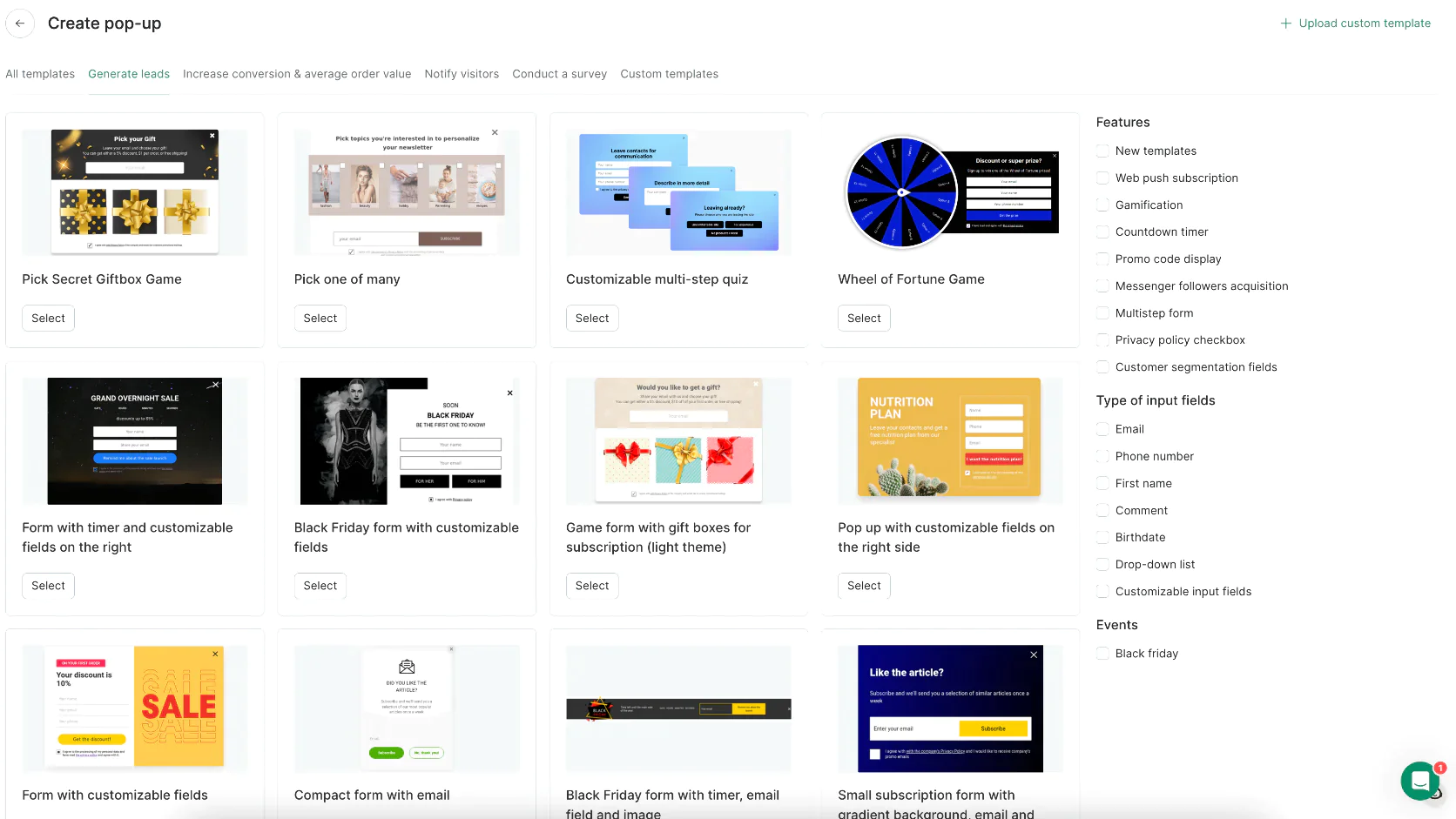
Maestra’s pop-up creation page
The details are where Maestra shines. Real-time triggers like “low stock in your size” or “price drop on an item you viewed” ensure your messages land when they matter most, nudging shoppers at just the right time. If a customer’s behavior changes, Maestra adapts—for instance, moving someone from a “browsing” sequence to a “cart abandonment” sequence seamlessly. The dynamic content and product recommendation engine means each email or SMS feels hand-picked for the individual. All of this is managed through a single interface, which cuts down the complexity that plagues many marketing stacks.
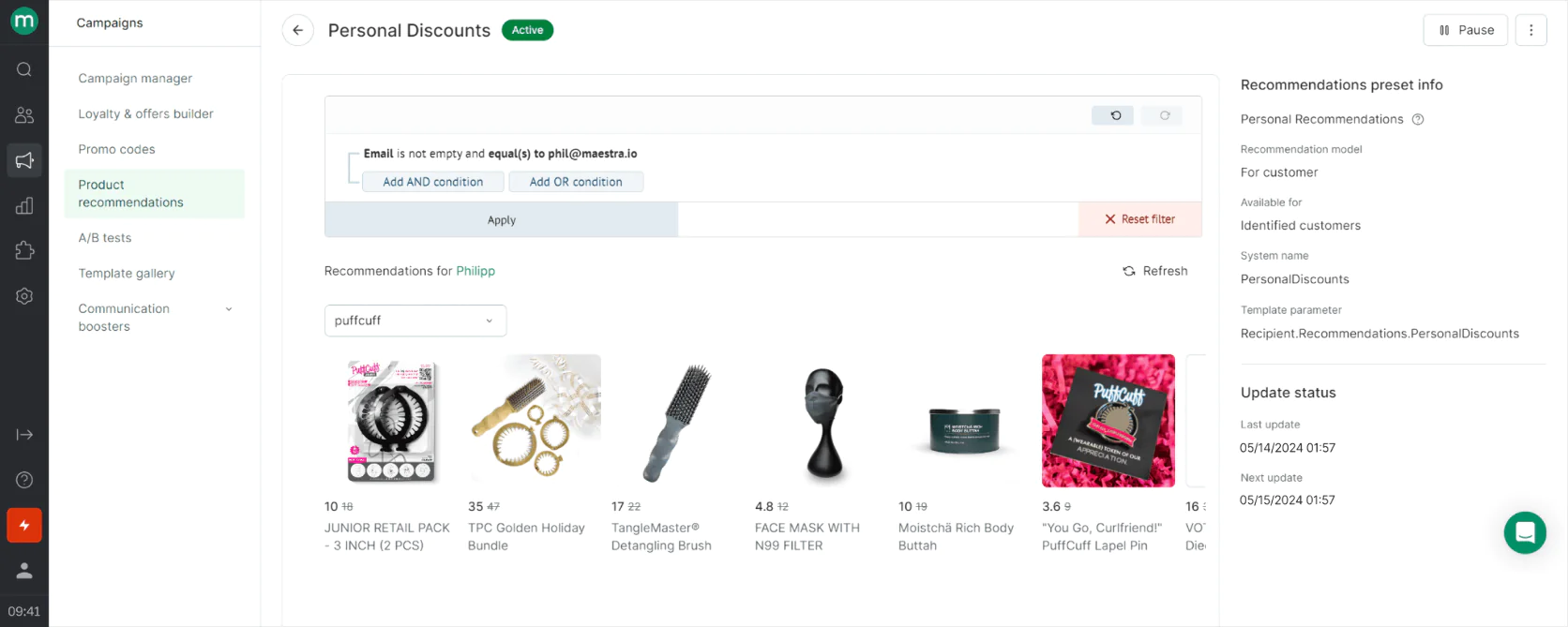
Personal product recommendations in Maestra
When it comes to drawbacks, Maestra doesn’t give you much to gripe about. However, its pricing starts at $2,990 per month, positioning it for rapidly scaling and mid-market brands. The cost reflects the value—it’s not just software; it’s effectively a full-service growth solution. That dedicated Customer Success Manager, for example, means Maestra is invested in your success, but it also means the platform is a significant investment.
Another area to note is that Maestra is laser-focused on marketing and customer experience. If you’re looking for a CDP purely to feed data into other systems for DIY analysis, Maestra might feel like overkill. It’s built for action, not just data storage.
Also, while Maestra excels in incentivizing and collecting customer feedback (reviews, NPS, etc.), it doesn’t have a standalone user-generated content display module—it relies on integrating that feedback into campaigns rather than curating UGC on a website.
Compared to Tealium
Tealium is okay for data collection and audience syndication, but it’s far from a complete marketing solution. Brands using Tealium often find themselves assembling a puzzle of tools—one for email, one for personalization, one for loyalty, etc. The result: a lot of juggling and potential data lag between systems.
Enlightened Equipment Achieves 15% Website Conversion Growth with AI-Powered Product Recommendations
Maestra eliminates the need for patchwork. Its real-time CDP is not just unified, but action-oriented—integrating customer data with email, SMS, push, ads, on-site personalization, and loyalty in one system. While Tealium might update a segment when a user takes an action, Maestra can update the segment and immediately act on it (send a message, adjust an offer) all in one go.
The immediacy is key: if a customer qualifies for a discount based on their behavior, Tealium could flag it, but Maestra will actually deliver it (say via a personalized email) at that moment.
Another difference is ease of use. Tealium often requires developer assistance to set up complex tracking or to wire it into all your channels. Maestra is designed for marketing teams to operate largely on their own—its UI is built for creating campaigns and journeys, not writing code. Plus, with the included strategy support (CSM and best-practice playbooks), Maestra feels less like a software purchase and more like bringing in a partner to accelerate growth.
In summary, if Tealium feels like a data pipe you have to build a marketing machine around, Maestra is the marketing machine, ready to go. For brands tired of duct-taping tools together—or losing realtime opportunities because their systems aren’t truly integrated—Maestra offers a chance to upgrade from data orchestration to true customer journey orchestration.
Tool #2: Twilio Segment
Best Tealium alternative for developer-friendly data integration
Twilio Segment (often just called Segment) is a leading customer data platform known for its ease of data collection and routing. Segment acts as the plumbing for customer data: you instrument your app or website once with Segment, and it funnels data to hundreds of other tools in the format each expects.
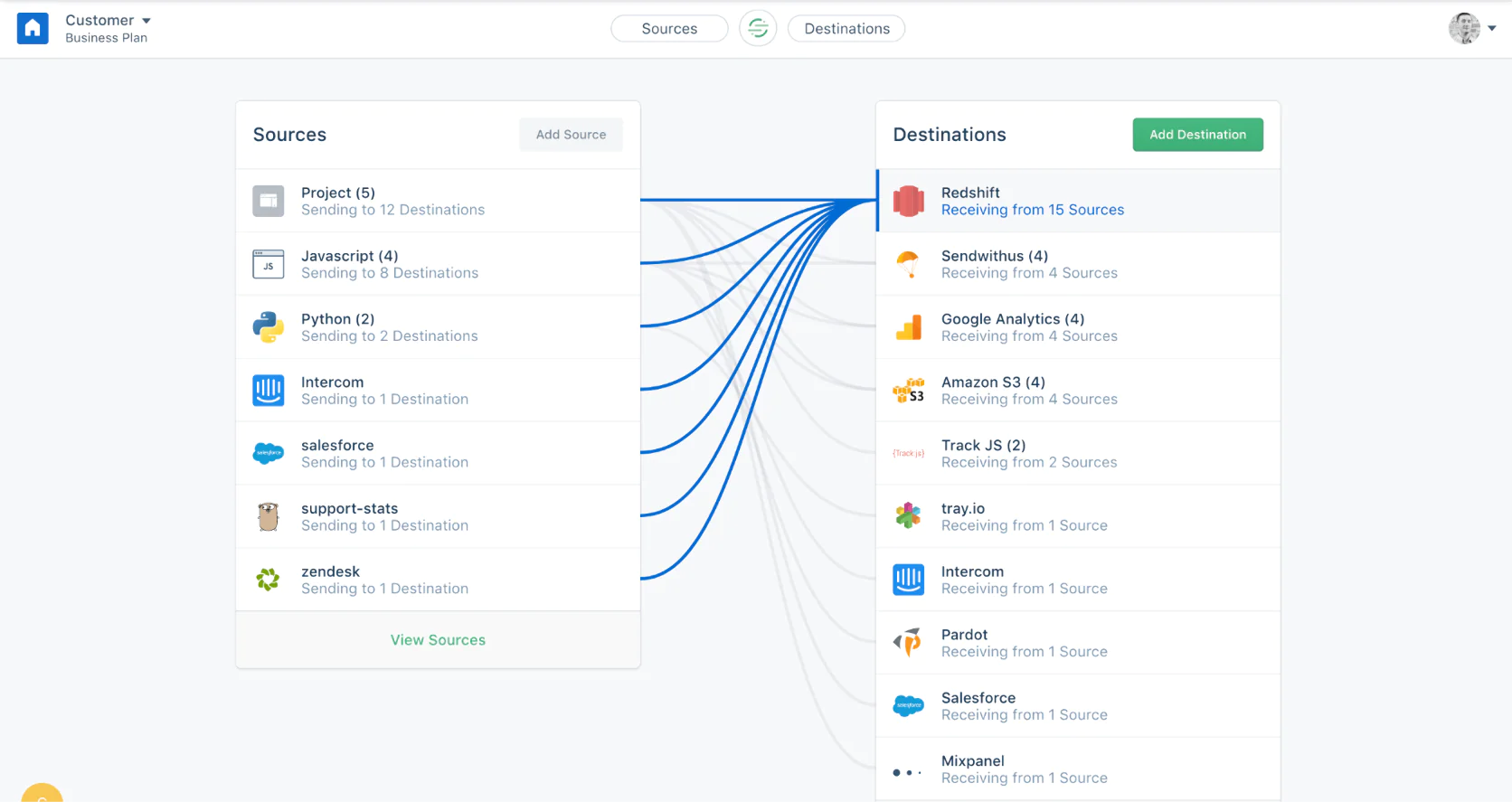
Data paths overview in Tealium
For teams with strong developer resources or a “build your own stack” mentality, Segment is an attractive Tealium alternative. It focuses on data quality and connectivity—ensuring every team (marketing, product, analytics) is working off consistent, clean customer data. Segment doesn’t send marketing messages itself, but it excels at feeding data to those that do.
Key Features:
- Unified data collection: Segment provides SDKs for websites, mobile apps, servers, and more, allowing you to track events and traits from all sources in a unified way. A single Segment implementation can replace dozens of individual analytics tags or API integrations. This “collect once, use anywhere” approach simplifies instrumentation dramatically.
- 300+ integrations (“destinations”): Segment boasts one of the largest integration catalogs. It can forward data to ad platforms (Google, Facebook), analytics tools (Google Analytics, Amplitude), CRMs, email providers, data warehouses, you name it. If you currently use Tealium connectors, you’ll find Segment has a comparable breadth of destinations.
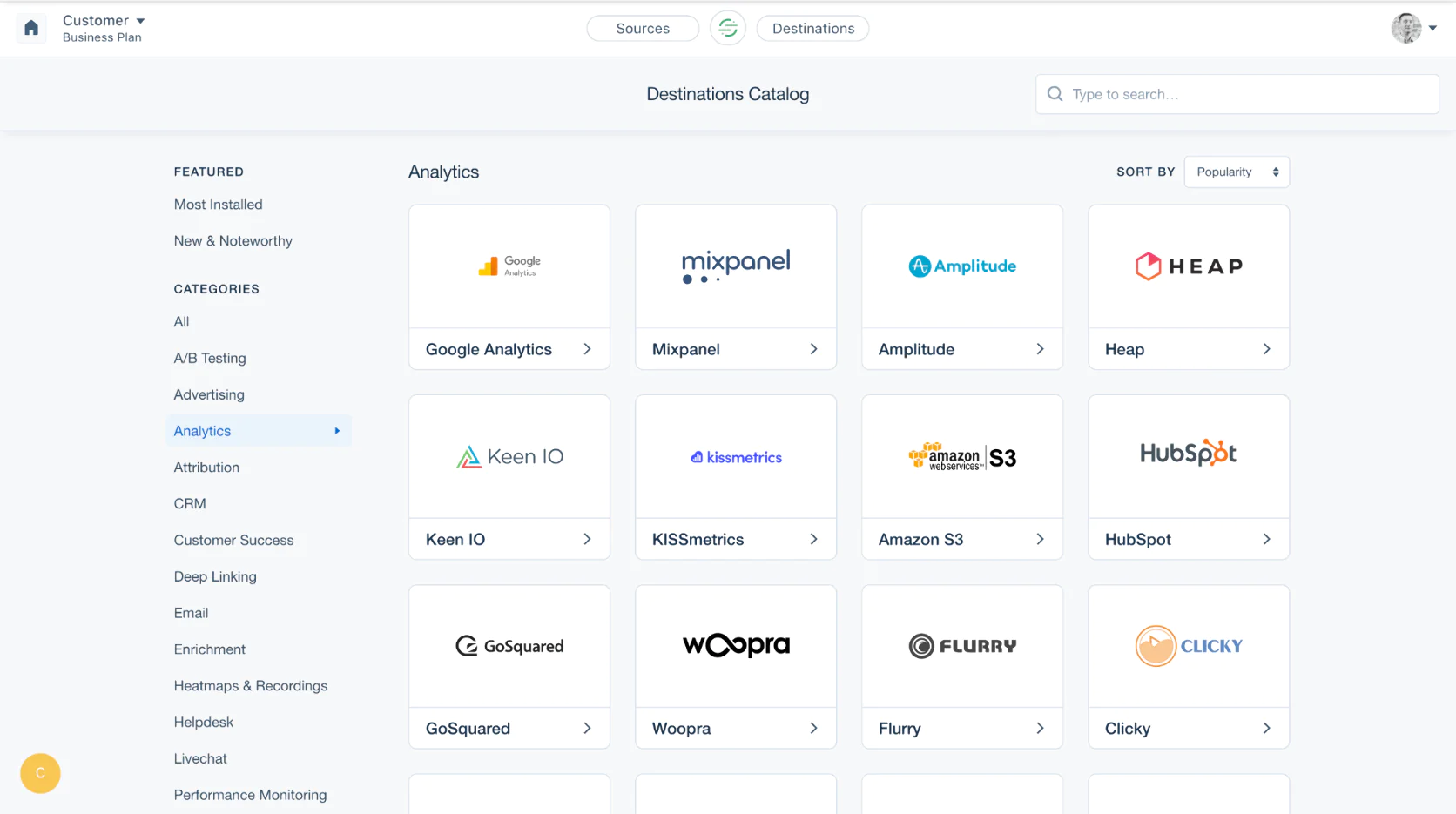
Tealium’s destinations catalog
- Real-Time streaming & transformations: Data flows through Segment in real time, so events (like a purchase or a page view) reach your other systems within seconds. Segment also offers Functions—custom code to transform or filter data on the fly. For example, you could hash an email before sending to a destination for privacy, or enrich an event with additional info.
- Tracking plan & schema enforcement: Through its Protocols feature, Segment lets you define expected events and properties, then flags (or even blocks) any data that doesn’t conform. This is a boon for data quality. It helps catch instrumentation bugs early and ensures consistency.
- Warehouse and reverse-ETL support: Segment can dump all your raw event data into data warehouses like Snowflake or BigQuery with its Forwarder destinations. It also introduced Profiles (Customer API) that allow pulling unified customer info from Segment into other tools, somewhat akin to a lightweight CDP querying. While not as full-featured as Tealium AudienceStream in building audiences, Segment integrates nicely if you’re taking a warehouse-centric approach (and new Twilio Engage features are pushing it further into audience management).
Strengths and Weaknesses
Segment’s strengths lie in its simplicity and reliability for data routing. Developers love it because it significantly reduces the effort to instrument new tools—add one line for Segment instead of 5 different analytics SDKs. Marketers benefit because when they want to try a new tool (say a personalization app or a new ad network), the data is already flowing; it’s a toggle in Segment, not a new code deployment.
The governance features are also a standout—Segment helps wrangle the wild west of event tracking into a clean, usable dataset. In essence, Segment is excellent at being the customer data pipeline and single source of truth for events.
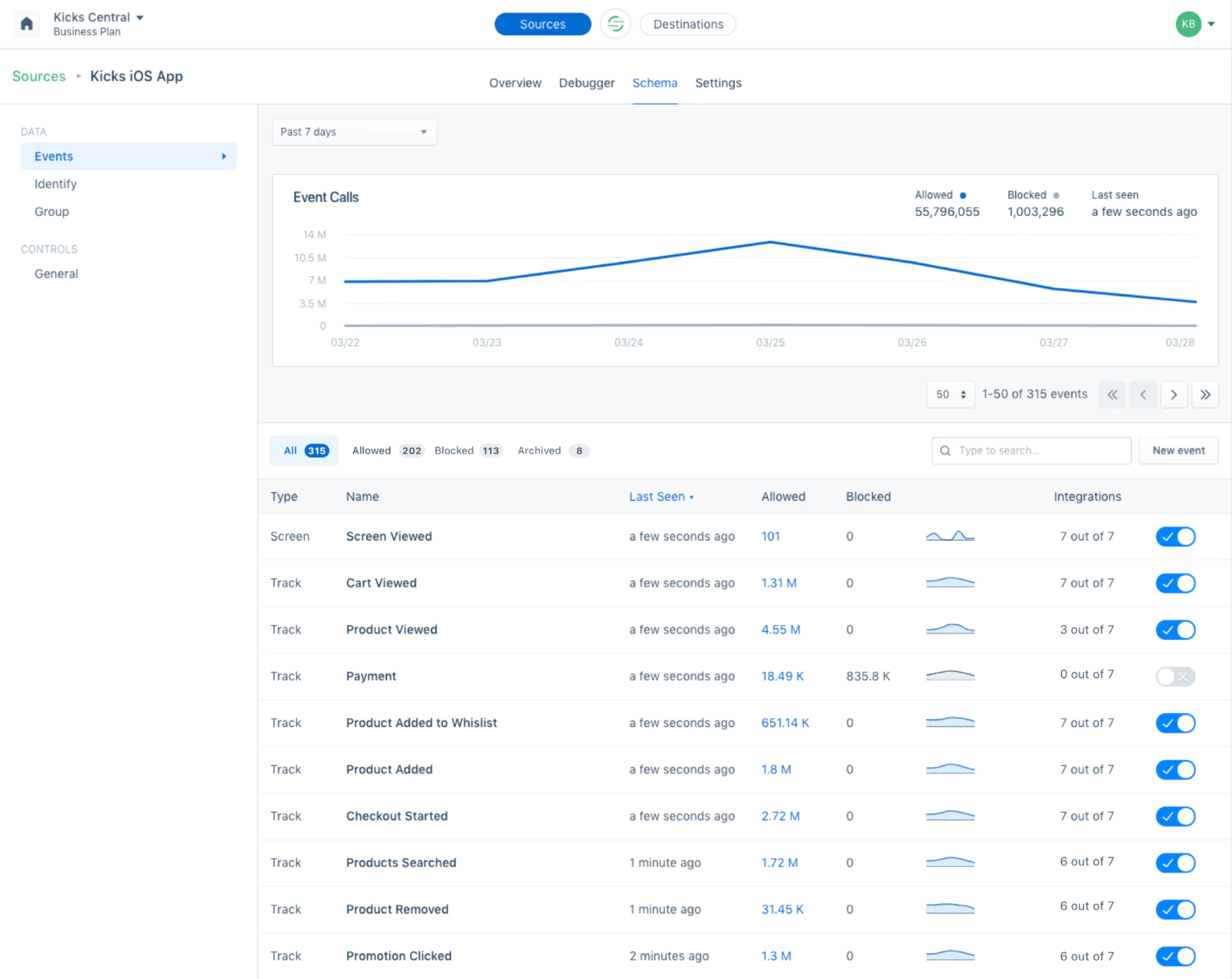
Events monitoring in Segment
A notable strength in context of Tealium: Segment’s interface and documentation are very approachable. Many users report being able to get basic tracking going without as much reliance on solutions engineers. The platform has a modern feel, reflecting its roots in the startup world, which can mean faster implementation for those familiar with developer tools.
On the flip side, Segment’s weaknesses emerge from the same philosophy—it’s intentionally not an all-in-one marketing suite. If you need a full CDP that not only collects data but also builds multi-channel campaigns or does heavy identity resolution, Segment alone isn’t sufficient. You would need to pair it with other tools (Twilio is in fact positioning Twilio Engage as an add-on marketing automation on top of Segment, but that’s separate).
Essentially, Segment can leave you with a similar outcome as Tealium: you have unified data, but you’ll require additional platforms to execute campaigns, do advanced journey orchestration, or manage loyalty programs.
Cost can also be a concern. Segment has a free tier for 1,000 monthly tracked users and a self-service Team plan (about $120/month for 10k users). Beyond that, pricing scales with MTUs (monthly tracked users) and features—and can become pricey at enterprise scale. However, Segment often replaces multiple point solutions (and its pricing often undercuts Tealium’s at comparable volume), so many find the value acceptable.

Finally, some very advanced users might find Segment’s identity merging capabilities limited compared to a dedicated CDP like Tealium or others—Segment recently introduced Profile APIs and identity stitching, but it’s still more rudimentary in profile unification than Tealium AudienceStream’s rule-based approach.
Compared to Tealium
Segment and Tealium often go head-to-head as CDP choices, and they do have overlap. Both collect data from myriad sources and fan it out to various destinations. Both aim to create a unified view of customer data. The differences lie in approach and ecosystem.
Tealium offers more onboard features around data once it’s collected—like building audiences natively and some edge functions—whereas Segment has historically focused on being an efficient conduit of data into other systems.
For instance, if you want to create an audience of “viewed product X but not purchased” and then send that to Facebook, in Tealium AudienceStream you could do that within its UI. In Segment alone, you’d probably send all data to a warehouse or to a tool like Personas/Engage to craft that audience.
In short, Tealium is a bit more marketer-friendly out of the box for audience creation, while Segment assumes you might use an external tool for that (or now Twilio Engage).
However, Segment shines in developer friendliness and time-to-implement. Users often note that implementing Segment took days, versus weeks or months for Tealium (particularly the tag management part).
The learning curve with Segment is often gentler—many find the UI more intuitive and the documentation highly developer-oriented (including open-source sample code). If your primary goal is to collect and distribute data cleanly, Segment can be a lighter lift than Tealium.
Another point is vendor lock-in and neutrality. Segment, being an independent (well, now Twilio-owned) CDP, sends data to all kinds of tools impartially. Tealium also integrates widely, but Tealium’s ecosystem has its own modules and a bit of a walled-garden tendency. Segment plays very well in the modern cloud environment—it’s easy to get raw data dumps in your own database. Tealium can export data too, but it’s not as center-stage as it is in Segment’s value prop.
In summary, if you have a strong tech team and want a best-in-class data pipeline (and you’re okay assembling other pieces for marketing activation), Segment is often a friendlier, possibly more cost-effective alternative to Tealium. It gives you the unified data layer without as much heavy lifting.
But if you loved Tealium for giving marketing users a UI to create segments and take action, know that Segment by itself won’t fill that gap—you’d need to add tools on top or consider Twilio’s broader Engage offering.
Compared to Maestra
Segment sticks to traditional CDP mechanics—collect and forward—whereas Maestra takes customer data and immediately acts on it.
Imagine with Segment (or Tealium): you set up tracking for cart events, then in another tool you detect cart abandonment and send an email. With Maestra, it’s one platform: the moment a cart is abandoned, Maestra’s real-time CDP triggers the email or SMS with an incentive. Segment would certainly pass the data to an email tool, but Maestra removes the middleman entirely.
Also, Segment is a toolkit, while Maestra is a ready-to-use application. Segment’s strength is its flexibility for developers—you can pipe data in very custom ways.
Maestra’s strength is giving marketers a rich toolbox (powered by data under the hood). For a brand that has already invested in building an in-house marketing stack, Segment fits like a glove in that architecture. But for a brand that wants quicker wins and fewer integrations to manage, Maestra is the “all-in-one” that Segment intentionally is not.
Lastly, consider support and strategy: Segment offers documentation and support, but Maestra offers a hands-on partnership (the dedicated CSM, etc.). Mid-size companies that lack a big analytics team could find Segment a bit do-it-yourself, whereas Maestra will proactively help execute.
Testimonial: Kyle Cannon, Digital Marketing Manager, Furniture Fair
In short, choose Segment if your priority is data infrastructure excellence and you have/will add the marketing tools around it. Choose Maestra if you want data + marketing activation unified, aiming to minimize assembly and maximize out-of-the-box capabilities.
Tool #3: Treasure Data
Best Tealium alternative for scalable enterprise CDP with rich analytics
Treasure Data is an enterprise-grade Customer Data Platform known for handling massive volumes of data and delivering powerful analytics and insights. It’s sometimes referred to as an “Intelligent CDP” due to its strength in data science integrations.

Customer profile in Treasure Data
Treasure Data positions itself as a one-stop hub to collect, unify, and activate customer data, similar to Tealium’s promise, but with a focus on big data and AI. If Tealium’s appeal was connecting data pipes, Treasure Data’s appeal is storing an ocean of data and using it to drive personalized marketing and business intelligence at scale.
Key Features:
- Broad data ingestion and integration: Treasure Data can pull in data from websites, mobile apps, IoT devices, backend databases, cloud apps—you name it. It offers SDKs and APIs, as well as batch file imports. One of its hallmarks is flexibility in data schema: it’s schema-on-read (you don’t have to predefine every data field). This makes it adept at ingesting semi-structured or large datasets (e.g., logs, big CSVs). For a company with huge amounts of customer data (retail transactions, device data, etc.), Treasure Data’s infrastructure is built to handle it.

Treasure Data’s integrations catalog
- Profile unification and identity resolution: Like Tealium, Treasure Data will unify events and attributes into customer profiles. It has an identity stitching system to merge identifiers (email, device ID, cookie ID, etc.) into a single customer view. Where it shines is scale—you can maintain tens or hundreds of millions of profiles, and Treasure Data’s backend (built on Apache Hadoop technology) can crunch through this efficiently.
- Advanced analytics and AI integration: Treasure Data includes a SQL-based query engine and integrates with Python/R for data science. Marketers or data scientists can run queries for segmentation or connect tools like Jupyter notebooks to develop machine learning models using the CDP data.
- Audience segmentation and activation: On the marketing side, Treasure Data has a user interface for building segments and audiences based on profile attributes and behaviors (e.g., “all users who viewed product A and haven’t purchased in 30 days”). These audiences can then be pushed to various connectors (they support dozens of ad networks, email platforms, and other marketing execution tools similar to Tealium’s connectors).
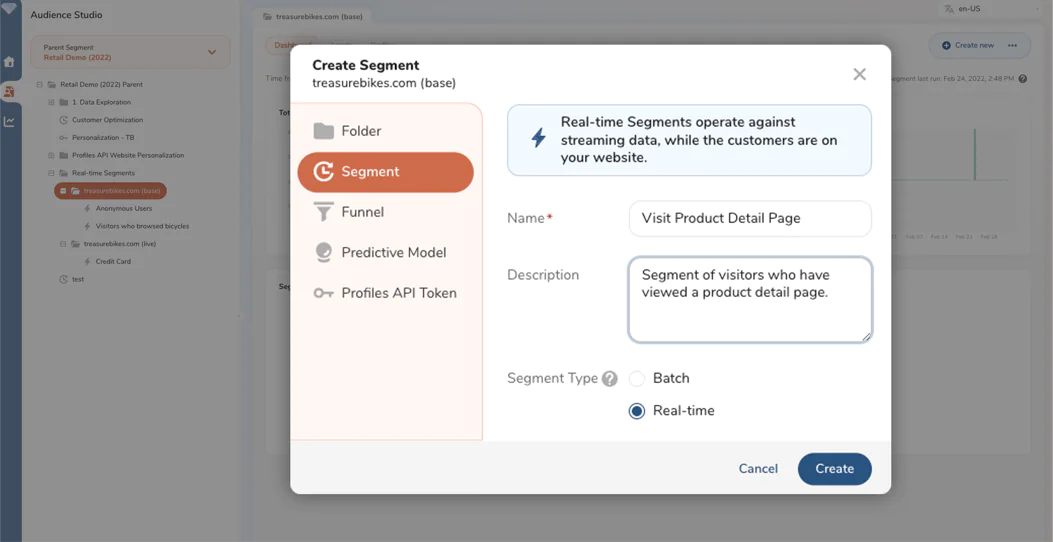
Segment creation in Treasure Data
- Security, compliance, and governance: As expected for an enterprise CDP, Treasure Data puts heavy emphasis on data security (ISO certifications, encryption) and privacy compliance. They have consent management capabilities and fine-grained permissioning so that different teams can access only the data appropriate for them. This is key when a CDP becomes the central customer data store for a big company—you might have thousands of users accessing it with various roles.
Strengths and Weaknesses
Treasure Data’s strengths are in its scalability and flexibility. It can truly be the single repository for all customer-related data, not just marketing events. Many Tealium users might only pipe in web and app behavior; Treasure Data encourages you to bring in POS data, call center records, loyalty program info, even second- and third-party data. It’s built to handle those large, diverse datasets and then allow complex querying.
Another strength is the analysis aspect. Treasure Data’s built-in query engine (using familiar SQL) means your analytics team can use the CDP as if it were a data warehouse. In fact, Treasure Data blurs the line between CDP and customer data lake. This is powerful—instead of exporting data out to analyze elsewhere, you do it in situ.
On activation, Treasure Data covers the bases well—many integrations and the ability to do things in real time. Its “Journey Orchestration” add-on allows some multi-step campaign logic (though it’s not as full-fledged as a dedicated journey tool).
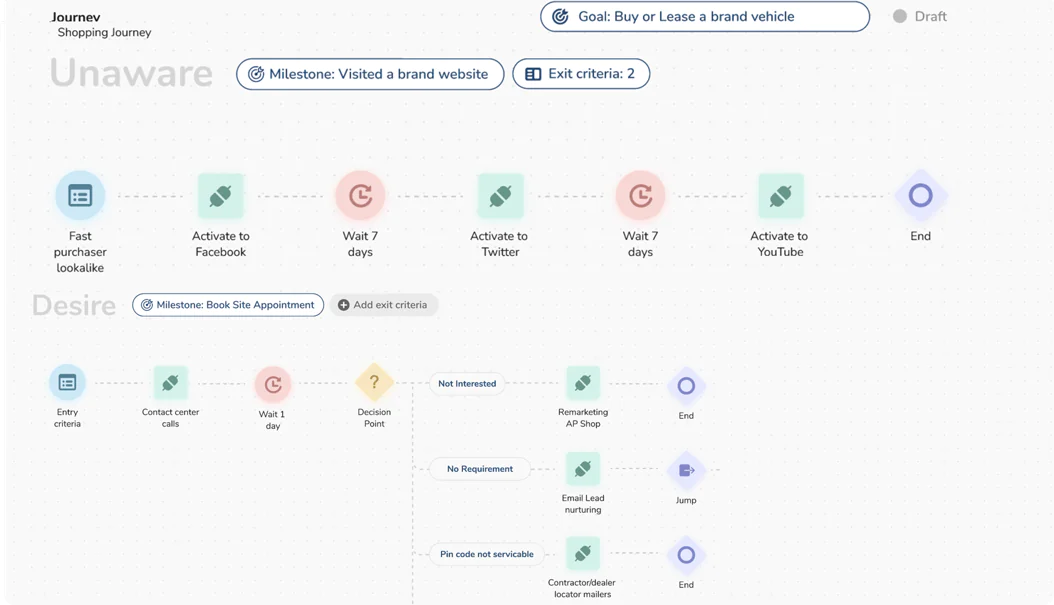
Treasure Data’s journey builder
Now, the weaknesses: Treasure Data, owing to its powerful capabilities, can be complex and heavy. The learning curve for non-technical users is steep. Marketers might find the interface less intuitive than some other CDPs or marketing platforms—it’s geared a bit more toward data engineers or technical marketers. In contrast, Tealium’s AudienceStream UI for building rules is more marketer-friendly with a point-and-click approach.
Treasure Data is also often deployed as a fully managed service (with solutions engineers helping), which implies a higher cost. It usually targets large enterprises (Fortune 500 type), and its pricing reflects that, commonly six-figure annual deals. So it may be overkill for mid-market companies that don’t have such vast data or who don’t need the on-platform analytics.
Finally, while Treasure Data has real-time activation, it was historically more batch-centric—some users note that it’s extremely powerful for “next day” insights and campaigns, but if you need sub-second reactions like triggering an in-app message at the exact moment of an event, other platforms (including Tealium or Maestra) can be more directly responsive.
Compared to Tealium
Treasure Data and Tealium share the CDP category but often appeal to slightly different audiences. Tealium might win in organizations that need a quick-turn, marketer-operated solution for known data sources (primarily digital) and immediate action triggers. Treasure Data wins where the scope is larger: many data sources (including offline), huge data scale, and the need to perform deeper analytics.
One way to look at it: Tealium’s DNA is tag management—it evolved upward to CDP. Treasure Data’s DNA is big data processing—it evolved downward to CDP. So, if you need a data platform that can do marketing, Treasure Data is compelling. If you need a marketing tool that wrangles data, Tealium is compelling.
In practice, companies that evaluate both sometimes choose Tealium for its edge processing and lightweight deployment, or choose Treasure Data for its comprehensive data lake approach. Tealium might be implemented by a marketing ops team, whereas Treasure Data might be driven by the data engineering or IT team in conjunction with marketing.
One key difference: Tealium often requires pairing with a separate data warehouse for advanced analysis, since pulling large data out of Tealium can be cumbersome or costly. Treasure Data can be that warehouse—saving complexity if you don’t already have a big data setup. On the other hand, if you do have a corporate data lake, you might question storing data in Treasure Data vs. in-house—whereas Tealium’s value might clearly be in real-time usage of data rather than heavy storage.
Compared to Maestra
Treasure Data is like a high-performance engine; Maestra is a fully built sports car. If you use Treasure Data, you’ll likely still need to plug in an email system, a personalization engine, etc., to actually use the data for customer experiences. Maestra provides those “wheels and chassis” out-of-the-box around the data engine.
Also, Treasure Data’s typical user base includes a lot of technical folks—data engineers, analytics teams—whereas Maestra is tailored to marketing practitioners. For an organization deciding between these two, it might come down to who is leading the project. A CMO looking for immediate marketing ROI might lean Maestra, whereas a CTO aiming to centralize data might lean Treasure Data, expecting the marketing activation will be handled by other tools.
In terms of capabilities: Treasure Data could theoretically power some of the same things Maestra does, but it won’t match the speed of execution of Maestra’s integrated approach. Maestra triggers and content personalization happen within seconds in one platform. With Treasure Data, that chain is longer (and relies on external execution systems).
Another distinction is loyalty and promotions—Maestra includes those natively, Treasure Data does not. So a retailer wanting to manage loyalty campaigns might find Maestra ready to go, while with Treasure Data they’d have to custom-build some workflows.
Cost-wise, Treasure Data might end up more expensive total (after including the marketing tools needed on top) unless you leverage it for a lot of use cases beyond marketing. For many, it comes down to whether you prefer a data hub you build around (Treasure Data) or a turnkey marketing growth platform (Maestra).
Tool #4: Salesforce Data Cloud (Customer 360, Salesforce CDP)
Best Tealium alternative for Salesforce-centric customer data unification
Salesforce Data Cloud—formerly known as Salesforce CDP or Customer 360 Audiences—is Salesforce’s entry into the CDP arena. If your organization lives and breathes Salesforce (Sales Cloud, Marketing Cloud, Commerce Cloud, etc.), Data Cloud is positioned as the glue to bring all that customer data together in real time.
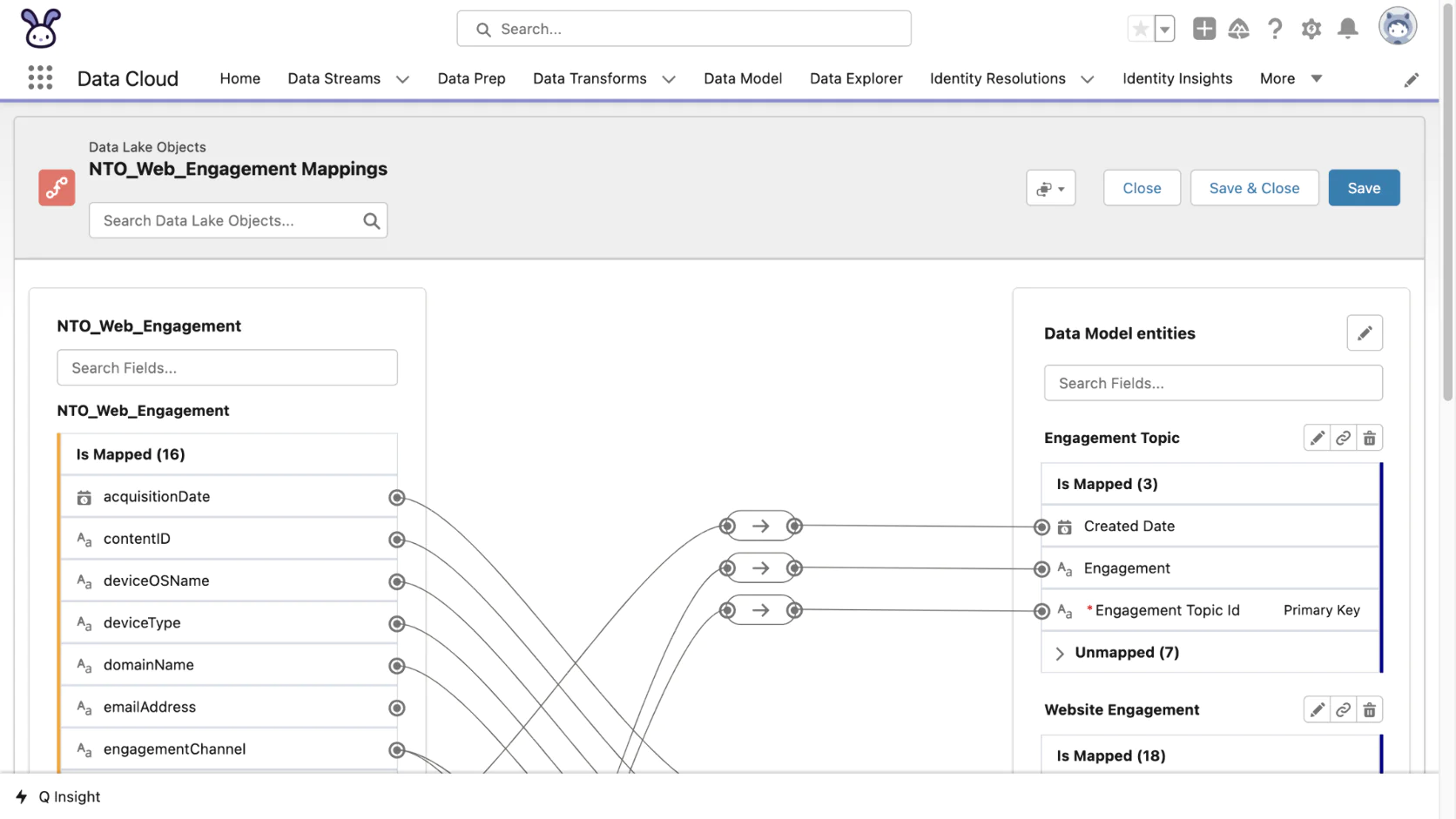
Data streams in Salesforce Data Cloud
It’s essentially a native CDP for the Salesforce ecosystem, leveraging the platform’s vast data and AI capabilities. As a Tealium alternative, it appeals to those who want an integrated solution tightly woven with their CRM and marketing automation, albeit with the trade-off of being Salesforce-exclusive in many ways.
Key Features:
- Unified Profiles across Salesforce apps: Data Cloud pulls data from various Salesforce products (e.g., CRM contacts, Marketing Cloud engagements, Commerce Cloud orders) as well as external sources, and matches them into a single Customer 360 profile. For a company already using multiple Salesforce products, this means no more data silos—the sales, service, and marketing data can live in one profile, updated in near real time.
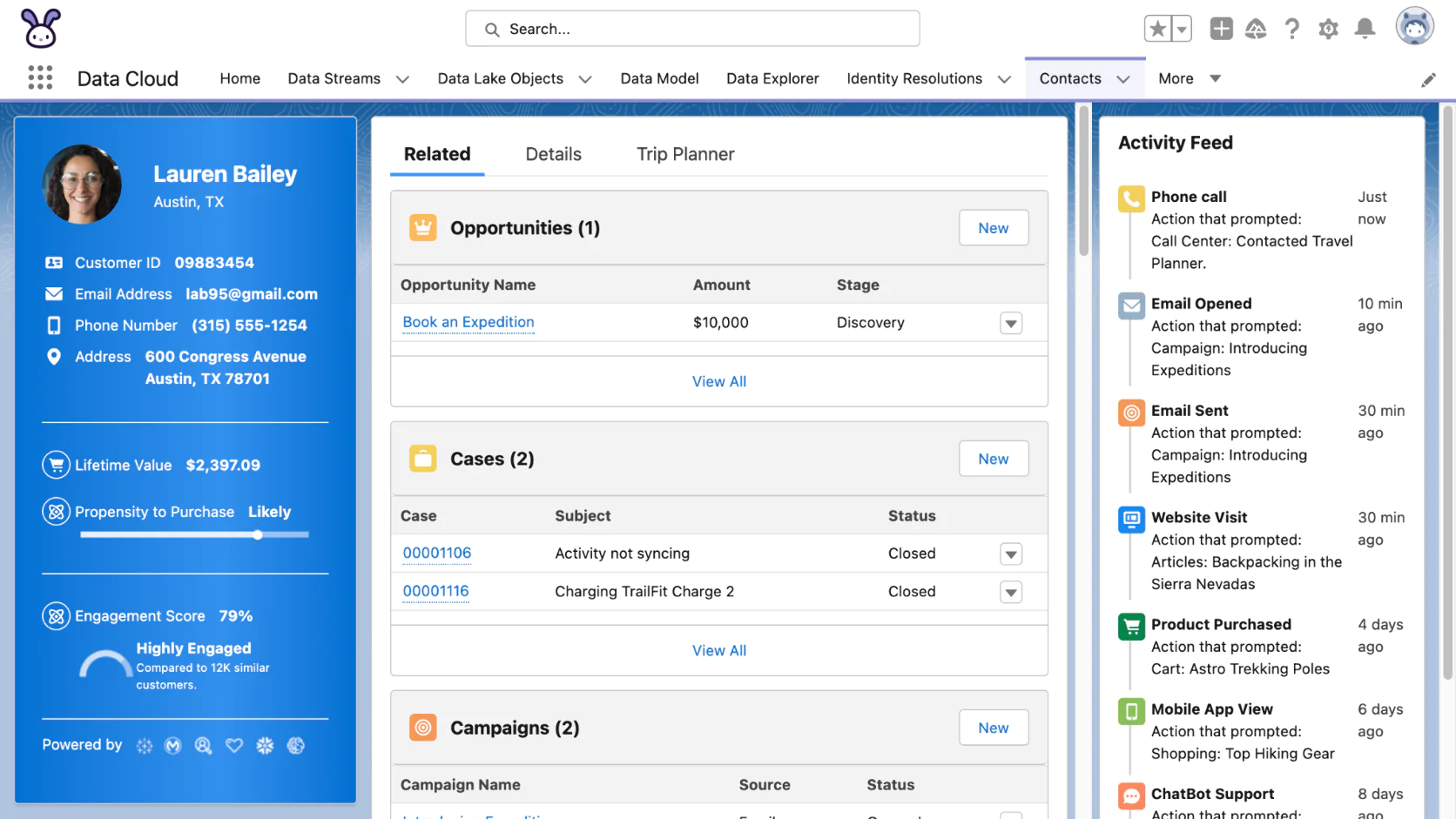
Customer’s profile in Salesforce Data Cloud
- Real-time data ingestion and identity resolution: Salesforce has built Data Cloud with a streaming architecture. Data from websites, mobile, point-of-sale, etc., can flow into the CDP and get unified on the fly. Identity resolution uses deterministic and probabilistic matching to stitch anonymous to known user, multiple emails to one person, etc. The goal is a continuously updated “global truth” of the customer that any connected cloud can use.
- Native activation to Salesforce Marketing Cloud & beyond: Once you create segments or audiences in Data Cloud, you can natively sync them to Marketing Cloud for campaigns, to Commerce Cloud for personalization, or even to external platforms via connectors. Data Cloud also supports using those segments in Advertising Studio to create ad audiences, and even in Service Cloud (so support agents can see what segment a customer is in).
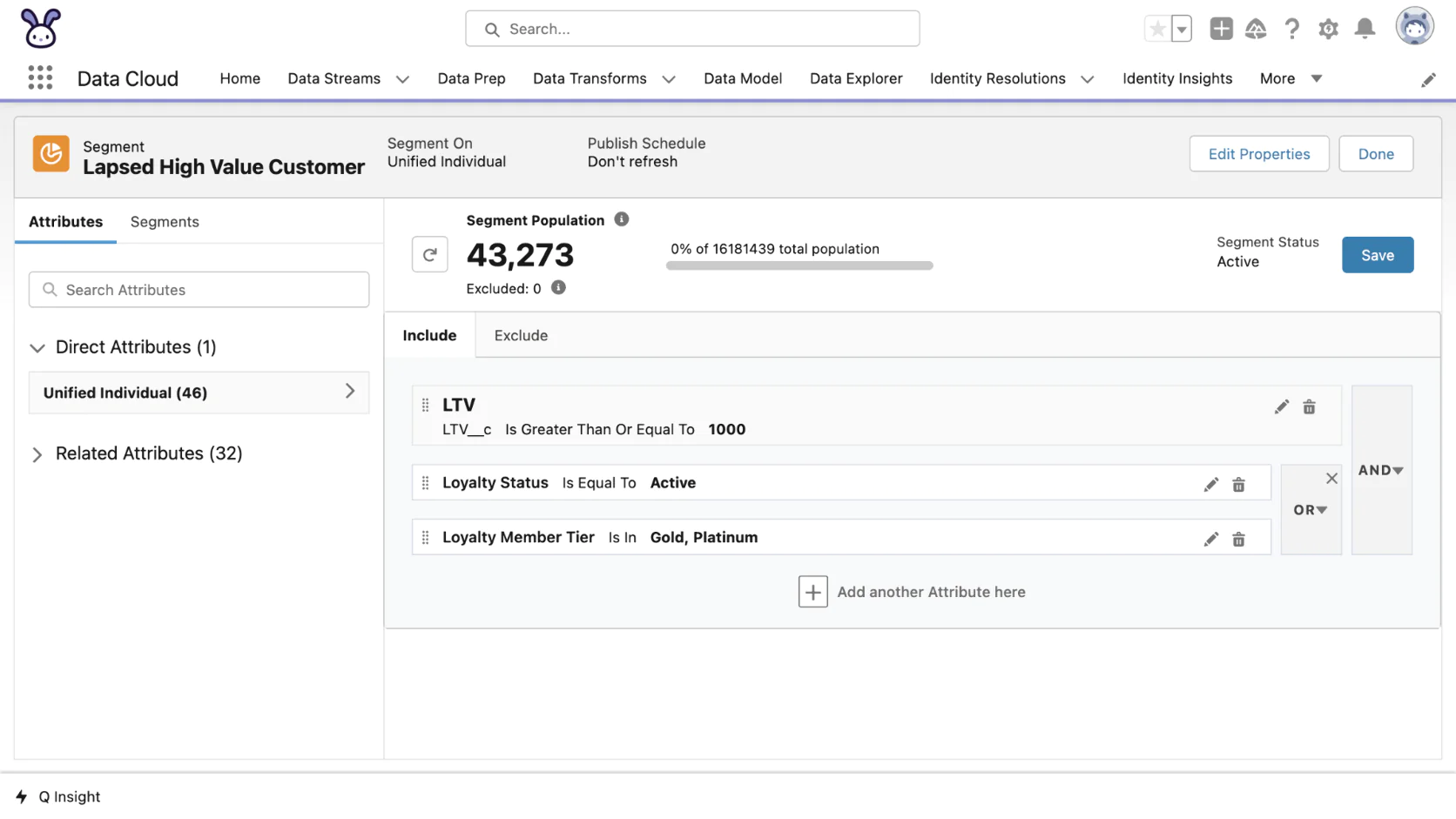
Building segments in Salesforce Data Cloud
- Einstein AI and analytics: Being part of Salesforce, Data Cloud can leverage Einstein AI for things like calculating engagement scores, product recommendations, or predicting churn. It also has an UI for segmentation and basic insights (like overlap analysis between segments). More complex analysis can be done by connecting to Tableau (Salesforce’s BI tool) or querying data via Salesforce’s query languages.
- Enterprise scale and compliance: Salesforce built Data Cloud to operate at huge scale—processing millions of events per hour—to accommodate large enterprises. It includes robust consent management (tying into Salesforce’s preference center) and adheres to Salesforce’s security protocols. For companies already trusting Salesforce with CRM data, extending that trust to the CDP for compliance is straightforward.
Strengths and Weaknesses
The biggest strength of Salesforce Data Cloud is seamless integration if you’re a Salesforce shop. Your marketing team might already be in Marketing Cloud, your sales in Sales Cloud—Data Cloud ties their data together without the friction of an external CDP.
The learning curve for Salesforce admins is also mitigated, since Data Cloud is accessed through familiar Salesforce interfaces. Additionally, the real-time aspect is a leap forward for Salesforce’s traditionally batchy world—Data Cloud’s streaming ingestion and immediate availability of data for use in, say, Journey Builder, is a win for real-time marketing.
And of course, Einstein AI being directly available on unified profiles can drive sophisticated personalization (like next-best-offer or likelihood scores) without a lot of custom dev.
Salesforce Data Cloud also reduces duplication: rather than having a separate user store in a CDP and then copying audiences into Salesforce, it becomes part of the Salesforce data fabric. This can simplify data governance—one system to secure and monitor (as opposed to adding a Tealium database plus the Salesforce databases).
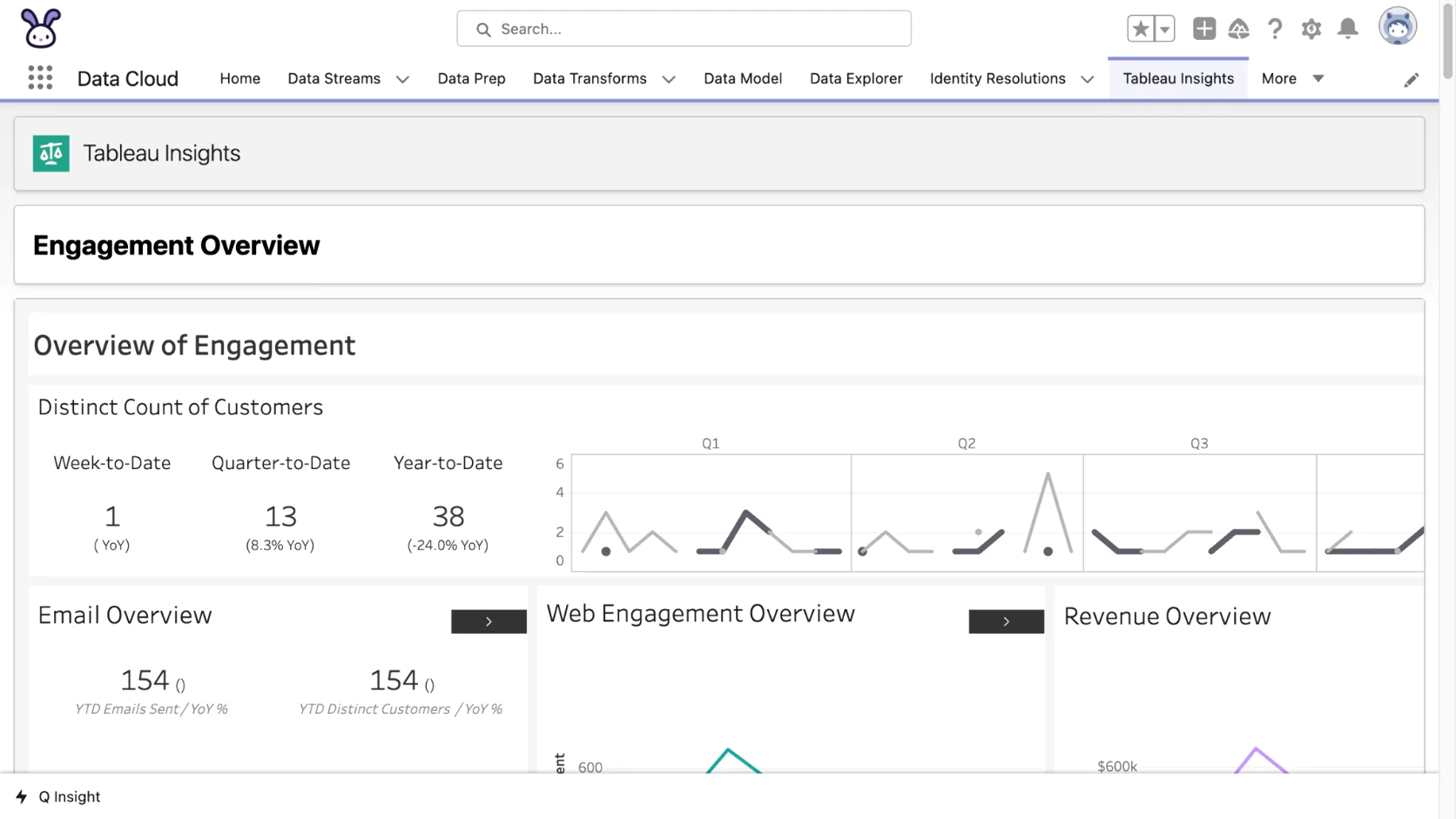
Salesforce Data Cloud’s reporting
However, weaknesses are notable.
First, Data Cloud largely benefits those deep in the Salesforce ecosystem. If you use non-Salesforce tools for, say, email or ads, Data Cloud may not integrate as smoothly as a neutral CDP would. Tealium or Segment, for instance, pride themselves on being vendor-neutral. Salesforce will focus on Salesforce integrations first.
Second, using Data Cloud can be complex and expensive. It’s an add-on to an already complex stack. Some early adopters found that implementing Salesforce CDP required significant help from Salesforce Professional Services or SIs. Essentially, it’s not a plug-and-play product; it’s more like an extension of your Salesforce architecture.
Licensing is a whole other matter: Data Cloud is typically a significant add-on cost on top of existing cloud licenses (often custom-quoted, with pricing factors like number of profiles or data storage). So you’re likely looking at a high price tag (rumors often cite six- to seven-figure annual costs for larger implementations).
Another weakness: Data Cloud shines when it can feed Salesforce Marketing, Commerce, and Service. If those aren’t in play, its value prop diminishes.
Finally, speed of innovation—ironically. Salesforce is huge, and while they are focusing heavily on Data Cloud now, independent CDP vendors often iterate faster with niche features. Tealium and others have years of feedback loops from CDP-specific use cases. Data Cloud is catching up in features.
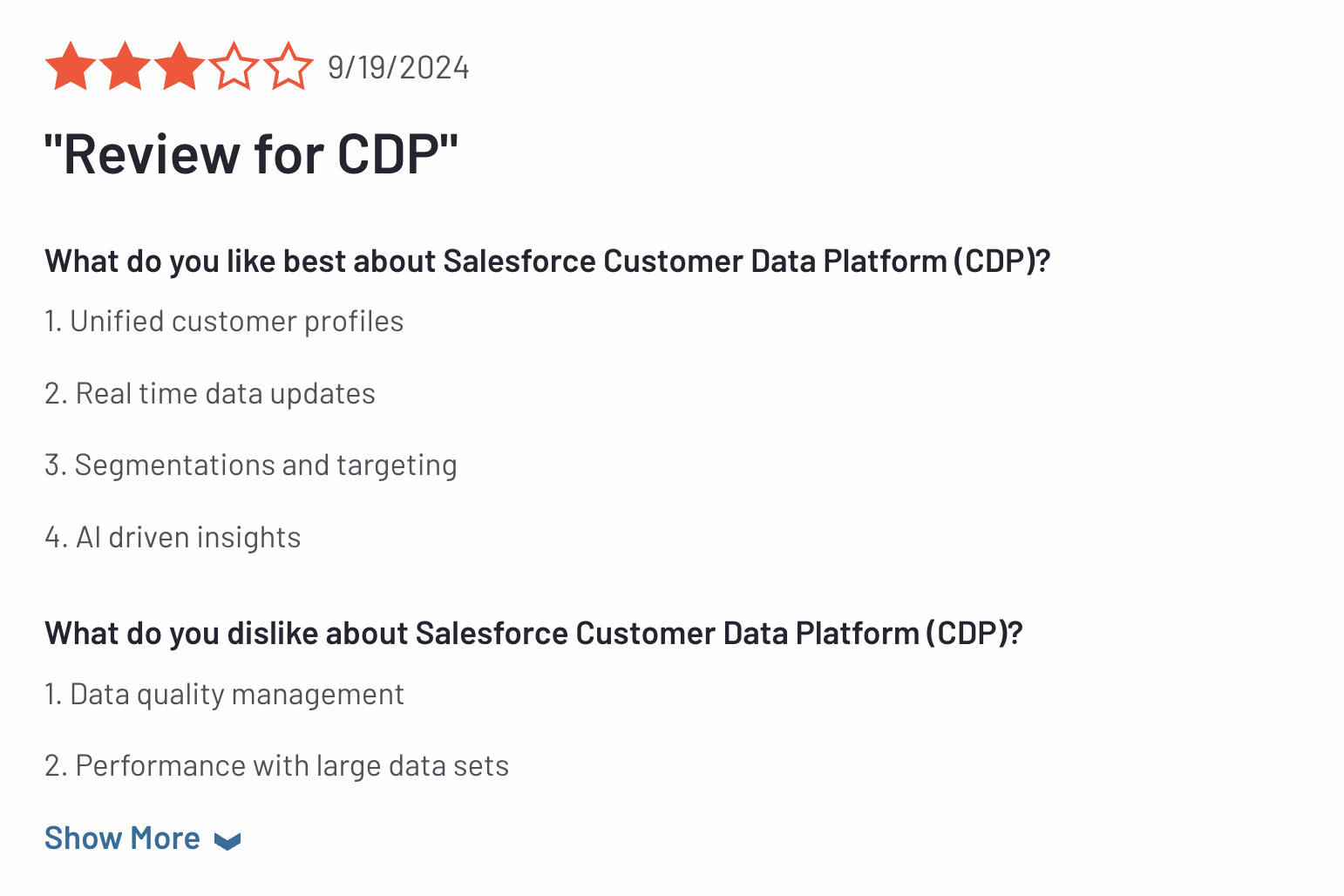
Compared to Tealium
For a Salesforce-centric organization, the decision could be: use Salesforce’s native CDP or a third-party like Tealium? The draw of Data Cloud is native integration—no connectors needed between CDP and Salesforce Marketing Cloud, for example.
Tealium would require setting up and maintaining those connectors (granted, Tealium has an integration for Salesforce Marketing Cloud, but it’s one more thing to maintain).
Data Cloud means if Salesforce updates something, it likely stays compatible; with Tealium, you might have to adjust mapping. Tealium, on the other hand, might offer more flexibility in a heterogeneous environment.
If you’re not 100% Salesforce, Tealium is built to connect to anything. Tealium could feed Adobe Campaign and Braze and SAP, etc.—Data Cloud would be out of place there.
So one could say, Tealium is multi-ecosystem, Data Cloud is single-ecosystem. If your ecosystem is Salesforce, that might not be an issue—it could even be a benefit.
Another point: Time to value. Tealium can sometimes be implemented faster in the sense that it’s a self-contained product with well-worn paths for integration. Data Cloud might involve aligning multiple Salesforce clouds and ensuring your org’s data model is in sync, which can be a longer project.
Companies with mature Salesforce usage might find Data Cloud straightforward, but others might be overwhelmed by the complexity of Salesforce’s platform.
Feature-wise, Tealium’s AudienceStream vs Salesforce Data Cloud share the basics (profiles, segments, connectors). Tealium may have an edge in certain real-time rule actions, while Salesforce has an edge in direct CRM integration (like updating a Sales Cloud field in a profile, etc.). Both handle identity resolution—likely similar results there.
One area Salesforce Data Cloud could surpass Tealium is in leveraging CRM data that’s typically hard to get out in real time. Since it sits on top of Salesforce, it can use things like live service interactions or sales stages in segmentation easier than pulling that data into Tealium (which might involve batch uploads or API calls). For a sales+marketing alignment use case, Data Cloud is compelling.
In summary, if you’re already deep into Salesforce and want a fully native solution—and have the budget—Data Cloud is almost a no-brainer to consider over Tealium. If you desire more independence or use a variety of martech brands, Tealium (or another CDP) might serve you better with less lock-in.
Compared to Maestra
Maestra and Salesforce Data Cloud are quite different in target user and purpose. Maestra is about action—orchestrating campaigns and personalization in one—whereas Data Cloud is about assembling data for use by other Salesforce products.
Salesforce Data Cloud by itself doesn’t give you an engagement tool—it relies on Marketing Cloud, etc. So one consideration: stack complexity vs single platform. Maestra gives you the CDP + multi-channel engagement in one solution (and at a cost that is competitive when you consider you’re getting several capabilities in one).
Another difference is focus on e-commerce: Maestra is heavily geared towards e-commerce metrics, behaviors, and has loyalty built-in. Salesforce Data Cloud is horizontal (any industry) and doesn’t inherently have e-com specific modules (though SF Commerce Cloud would complement it).
If you’re a retail brand, Maestra might feel more immediately relevant with its out-of-the-box flows (like cart abandonment, win-back, etc.) whereas Data Cloud would require you to build those journeys in Journey Builder using the data.
From a usability perspective, Maestra is marketer-led; Data Cloud is admin/IT-led. A marketing team could directly drive Maestra usage. Data Cloud usually involves Salesforce admins or IT to set up data streams and then marketers use the segments in Marketing Cloud (so a bit indirect).
Finally, consider independence: If avoiding vendor lock-in is important, Maestra (an independent platform) might be preferred over deepening reliance on Salesforce.
In short, Maestra vs Salesforce Data Cloud is a decision between a focused, all-in-one growth platform and a component of a larger enterprise ecosystem.
Companies prioritizing agility, ease of use, and a unified tool might lean Maestra, while those heavily invested in Salesforce’s world and looking to maximize those investments might lean Data Cloud.
Tool #5: Adobe Real‑Time CDP
Best Tealium alternative for enterprise marketing cloud integration
Adobe Real‑Time CDP is Adobe’s customer data platform offering, part of the Adobe Experience Platform (AEP). It’s designed to unify customer data from across channels (both known and anonymous), and make those profiles available in real time for personalization and marketing through Adobe’s suite (and beyond).
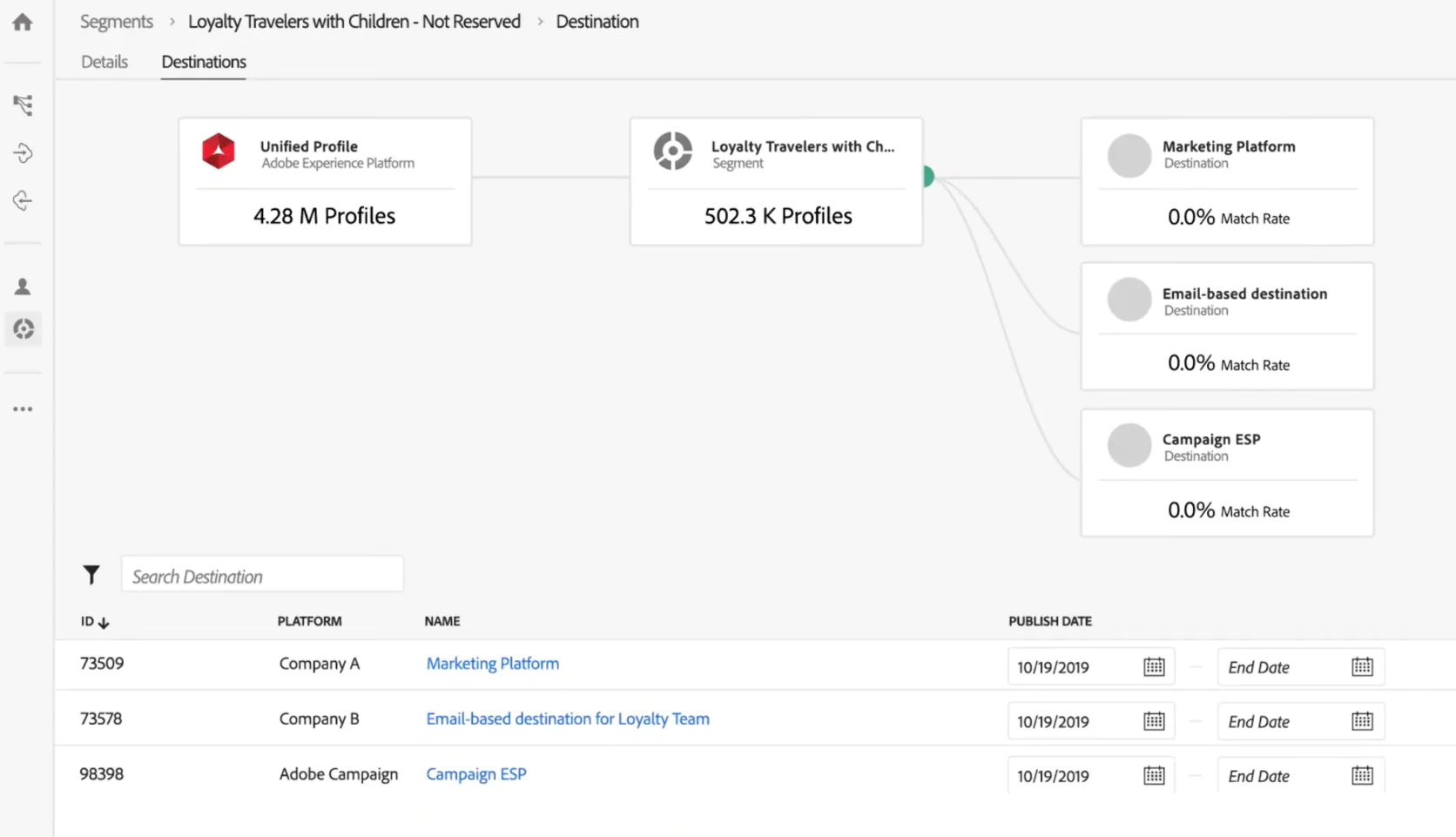
Data streaming in Adobe Real‑Time CDP
For organizations already using Adobe Experience Cloud products (Analytics, Target, Campaign, Magento, etc.), Adobe’s CDP presents an attractive option to centralize data natively. It’s essentially Adobe’s answer to Tealium: control your data pipeline, but with seamless hand‑offs to Adobe’s marketing and experience tools.
Key Features:
- Real‑Time unified profiles: Adobe RT‑CDP continuously collects data from web, mobile, CRM systems, and other sources, stitching together identities into a Person Profile (for individuals) and even Account Profile (for B2B scenarios). The system is built on Adobe’s Experience Platform, which uses a robust identity graph to merge customer identifiers.
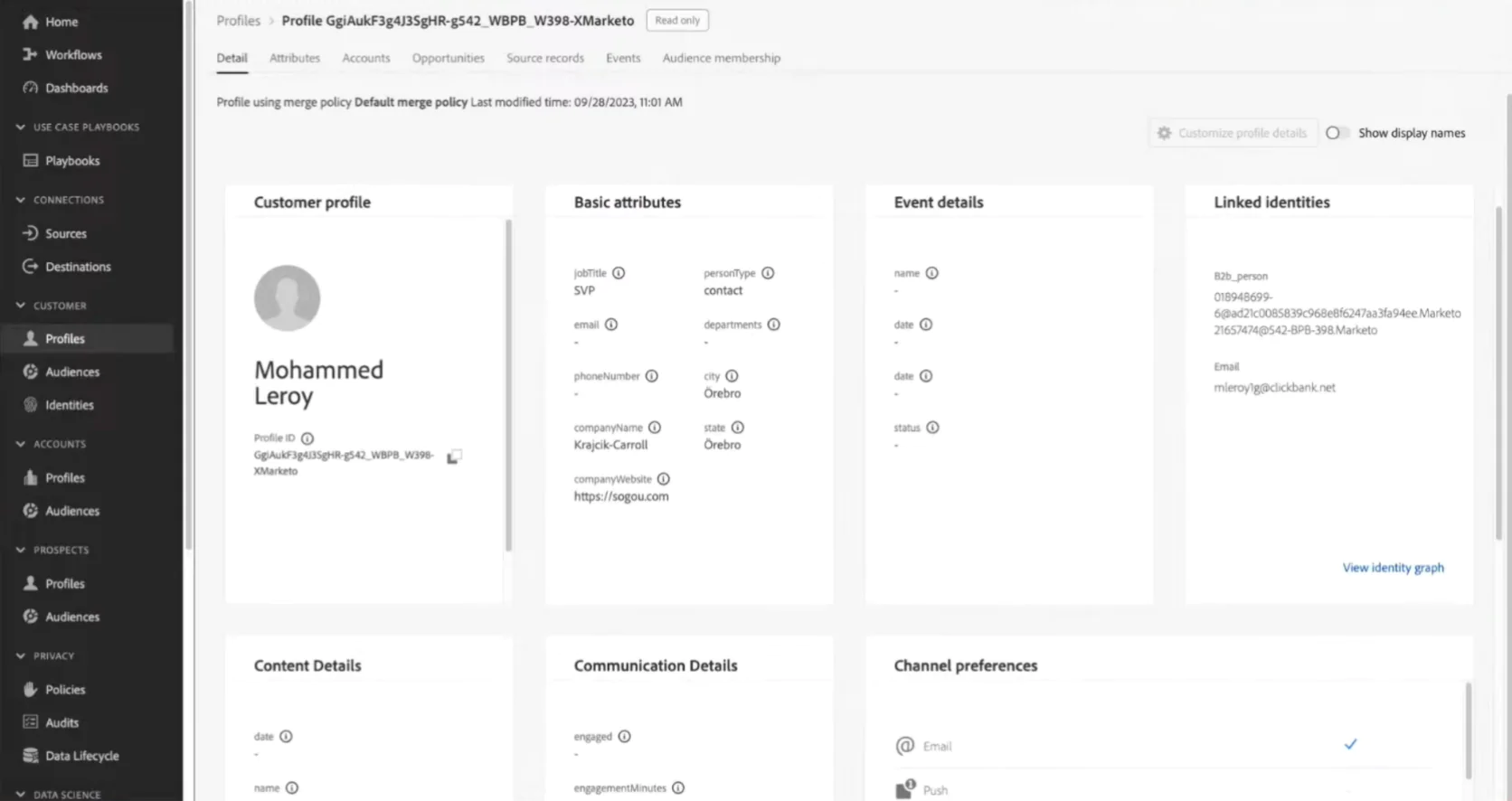
Customer’s profile in Adobe Real‑Time CDP
- Experience Data Model (XDM): Adobe uses a standardized schema (XDM) for customer events and attributes. All incoming data is conformed to this model. This is powerful for consistency—when you look at a profile or segment, all data is speaking the same language (e.g., “Email Clicked” events from any source have the same structure). It helps large enterprises manage complex data by standardizing it.
- Segmentation and audience creation: Through a friendly UI, users can define segments using any profile attributes or behaviors (e.g., “Loyal shoppers in NYC who viewed product X”). The segmentation engine leverages Adobe’s back‑end to compute these segments quickly, even on very large datasets. One neat feature is “segment match” which allows secure sharing or enrichment of segments with partners (in a privacy‑safe way)—essentially a lightweight data clean room.
- Activation to marketing channels: Adobe Real‑Time CDP integrates natively with Adobe’s activation products. For example, a segment defined in RT‑CDP can be sent to Adobe Target for personalization or to Campaign for an email blast, with a few clicks. Additionally, Adobe provides connectors to non‑Adobe destinations like Facebook, Google Ads, email providers, and others—similar in spirit to Tealium connectors.
- Customer Journey Analytics and Insights: With all data centralized, Adobe offers analytics on top (beyond just raw querying). There are dashboards and Journey Analytics to explore things like cross‑channel pathing, segment overlaps, lifetime value, and more. Moreover, Adobe’s AI (Adobe Sensei) comes into play for predictions—e.g., propensity scores or anomaly detection—which can be added to profiles automatically.
- Privacy and governance: Adobe’s CDP has built‑in consent and preference management. It allows marking data with labels (like GDPR, CCPA flags) and ensuring those govern whether a profile can be included in an activation.
Strengths and Weaknesses
Adobe Real‑Time CDP’s major strength is its tight integration with the Adobe marketing stack.
If you use Adobe Analytics for web tracking, that data can flow into the CDP seamlessly (and vice versa, segments from the CDP can be analyzed in Analytics). If you use Adobe Target for personalization, it can directly tap into the CDP profiles to change content on the site for known users. This end‑to‑end integration can unlock advanced use cases—for instance, a customer’s behavior on the website (captured by Analytics, fed to the CDP) can instantly adjust an email offer (via Campaign), all under Adobe’s roof.
The system is truly real time in profile updates and in making that data actionable. Adobe has re‑architected a lot on modern cloud tech (unlike some older Adobe tools) to ensure low‑latency data processing.
Another strength is breadth and depth: Adobe’s CDP can handle both B2C and B2B (account‑level) data, which not all CDPs do out of the box. It’s built for large enterprises, meaning high‑volume capacity and sophisticated control.
Adobe’s interface, while enterprise‑grade, has been improving for marketer usability—segmentation is fairly visual now.
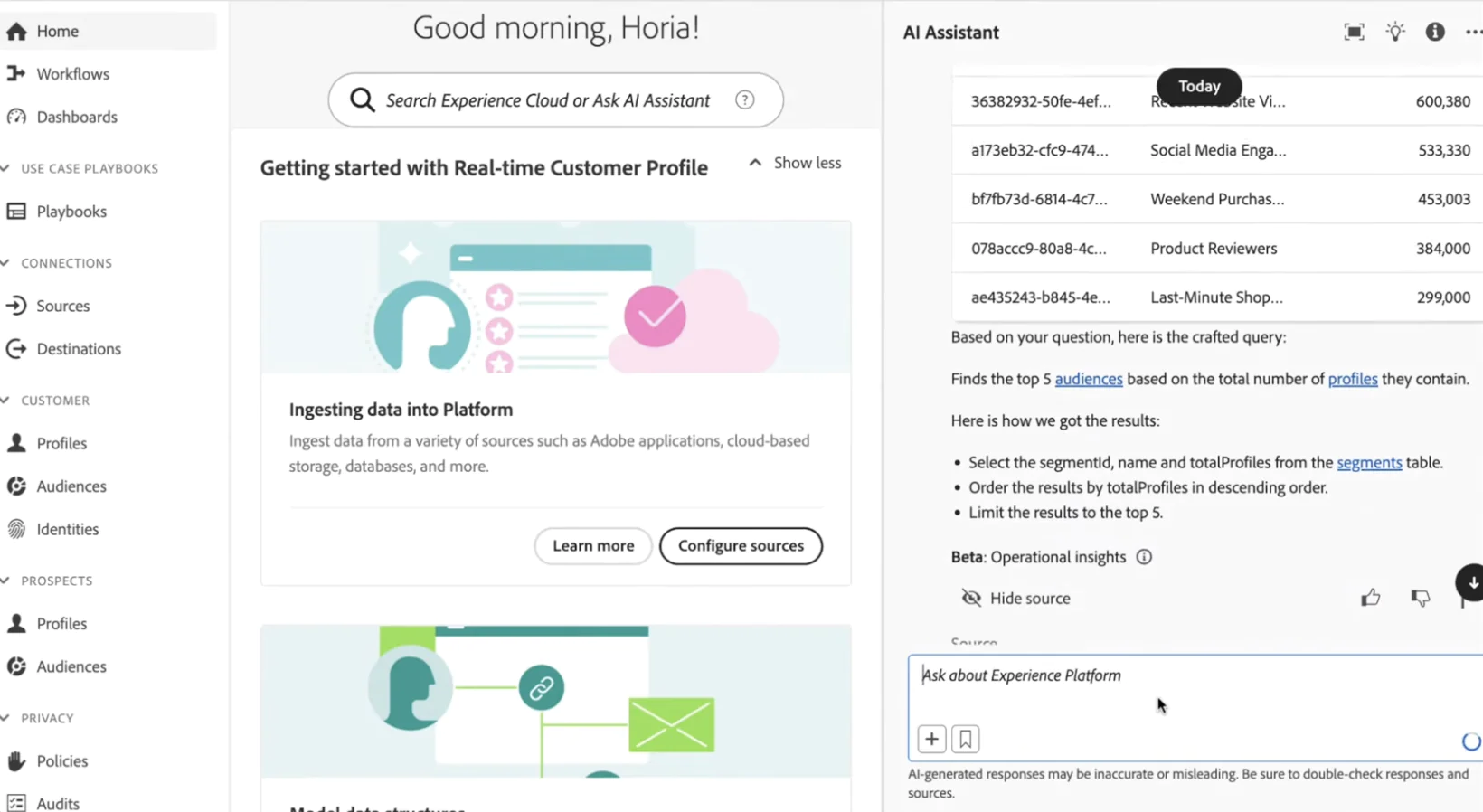
Adobe Real‑Time CDP’s AI Assistant
The primary weakness is complexity and resource requirement. Adobe’s Experience Platform (and its CDP) is a behemoth. Implementing it often requires significant expertise (often Adobe’s own consulting or experienced partners). It’s not a plug‑and‑play CDP for a small team. You need architects who understand XDM schemas, integration developers to set up data sources and connectors, etc. This can mean higher implementation cost and time compared to a Tealium or Segment.
Additionally, cost is unsurprisingly high. Adobe typically sells Real‑Time CDP to large clients with big budgets. It’s usually bundled or sold in connection with other Adobe products.
Another potential weakness: if you’re not using Adobe’s campaign tools, Adobe CDP might feel less compelling. Yes, it can connect to non‑Adobe destinations, but part of its value is “native with Adobe.” If your marketing execution is with Salesforce or Braze or something, a neutral CDP could integrate just as well or better without the overhead of Adobe’s platform.
Some critics also note that Adobe’s UI, while improving, can lag behind more modern SaaS CDPs in simplicity. It’s powerful but not the most intuitive for an average marketer to dive into without training.
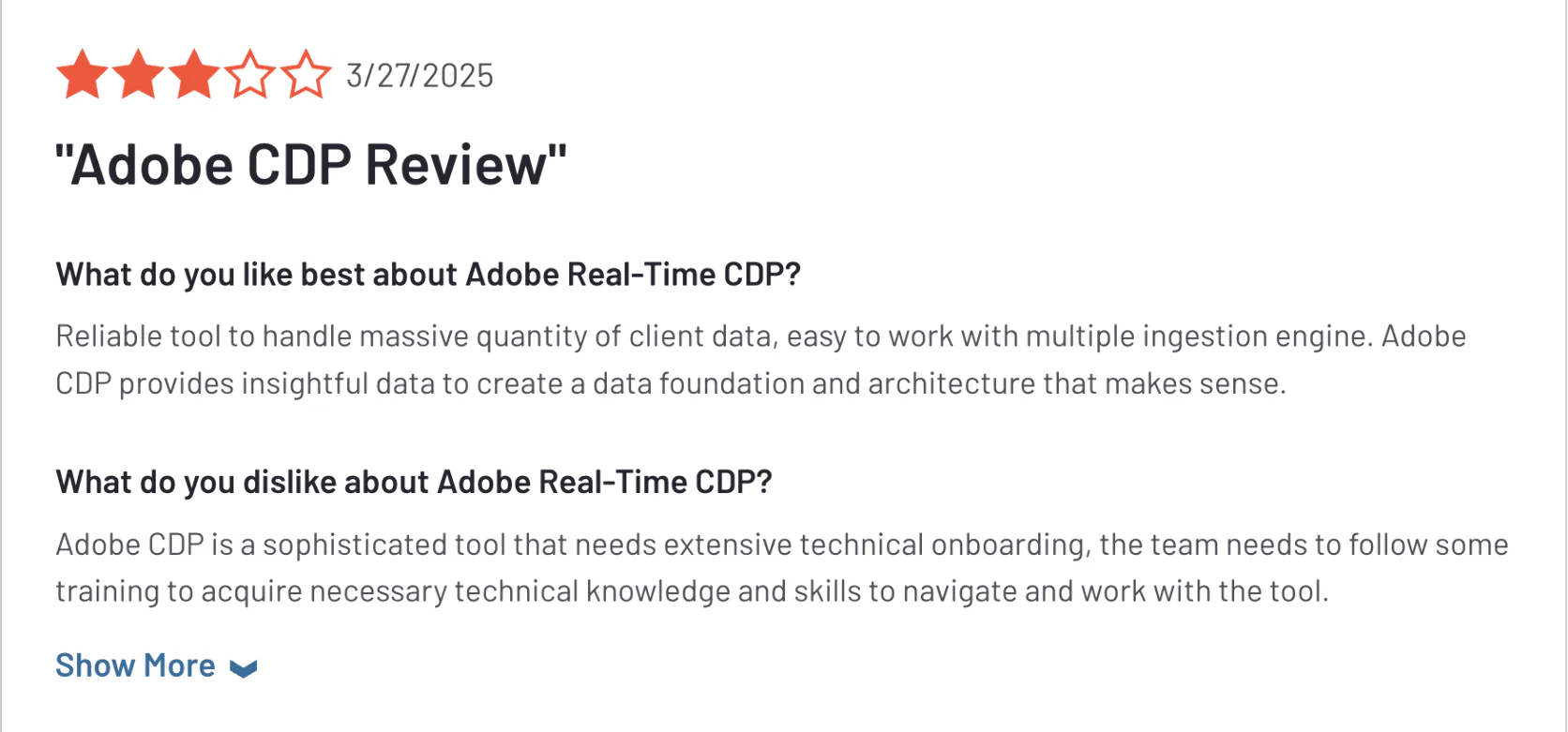
Finally, like any enterprise CDP, realizing value requires multi‑team coordination—IT for data, marketing for strategy, etc. This is not necessarily a flaw, but a reality: Adobe’s CDP is often part of a large digital‑transformation project, not a quick SaaS tool you turn on.
Compared to Tealium
Both aim to unify profiles and push to various channels, but they come from different lineages. Tealium started in tag management, Adobe in digital‑marketing suites.
Tealium is often praised for its user‑friendly rule building and quick deployment for marketing purposes. Adobe’s CDP might require more upfront data modeling (you have to map your data into their XDM structure, which is a project in itself). Tealium might be more flexible with ingesting arbitrary events and letting you define rules on them in a simpler interface. On the activation side, Tealium has many connectors, including to Adobe’s own tools.
But Adobe CDP will obviously have the best integration with Adobe tools (no surprise). So if your channel mix is heavy on Adobe , Adobe CDP will feel like it “completes” that puzzle more elegantly than Tealium, which sits outside.
One big difference: Analytics and Data Science. While Tealium has some event‑level data access and simple aggregates, Adobe’s platform is much more analytics‑friendly at scale. If analysis of customer data within the platform is important, Adobe wins there (you can use Adobe’s Query Service, feed to Adobe Analytics Workspace, etc.). Tealium likely would rely on exporting data out to a BI tool for heavy analysis.
In summary, if you’re already deep into Adobe’s ecosystem, adopting Adobe Real‑Time CDP might make sense—especially if you need tight integration with Adobe Campaign and Adobe Target. Tealium might be better if you are multi‑stack or need a more flexible, neutral CDP.
Compared to Maestra
Adobe Real‑Time CDP is a part of the Adobe Experience Cloud puzzle, whereas Maestra is a self‑contained solution. To achieve with Adobe what Maestra offers, you’d likely need Adobe’s CDP plus Adobe Campaign (or Journey Optimizer) plus Adobe Target plus maybe Adobe Commerce integration. That’s multiple systems (each powerful, but separate). Maestra rolls those functions into one.
Thus, Maestra offers simplicity and agility where Adobe offers customizability and depth. A marketer could use Maestra end‑to‑end; with Adobe, marketers use Campaign/Target, and data engineers/admins use the CDP to feed those.
Cost‑wise, Maestra is far more accessible for mid‑sized companies. Adobe’s stack might be feasible only for large enterprises with multi‑million‑dollar marketing‑tech budgets.
Maestra can often be deployed faster, too—Adobe projects might take many months to go live fully.
However, for an enterprise already in Adobe’s ecosystem, adopting Maestra might seem redundant or disconnected—they might prefer to “build within Adobe.” For a mid‑market or e‑commerce brand that doesn’t have such commitments, Maestra offers a much faster time to value.
In summary, Maestra vs. Adobe is agility vs. breadth. Maestra is “batteries included,” Adobe is “assemble the best‑of‑breed parts.” An organization with a lean team likely gets more from Maestra, whereas one with a large tech team and existing Adobe investments might lean Adobe for synergy.
Tool #6: mParticle
Best Tealium alternative for mobile-centric data orchestration and control
mParticle is a customer data platform that has made a name for itself particularly in the mobile app ecosystem and among product-focused teams. Much like Segment, mParticle is about collecting, unifying, and distributing customer data.
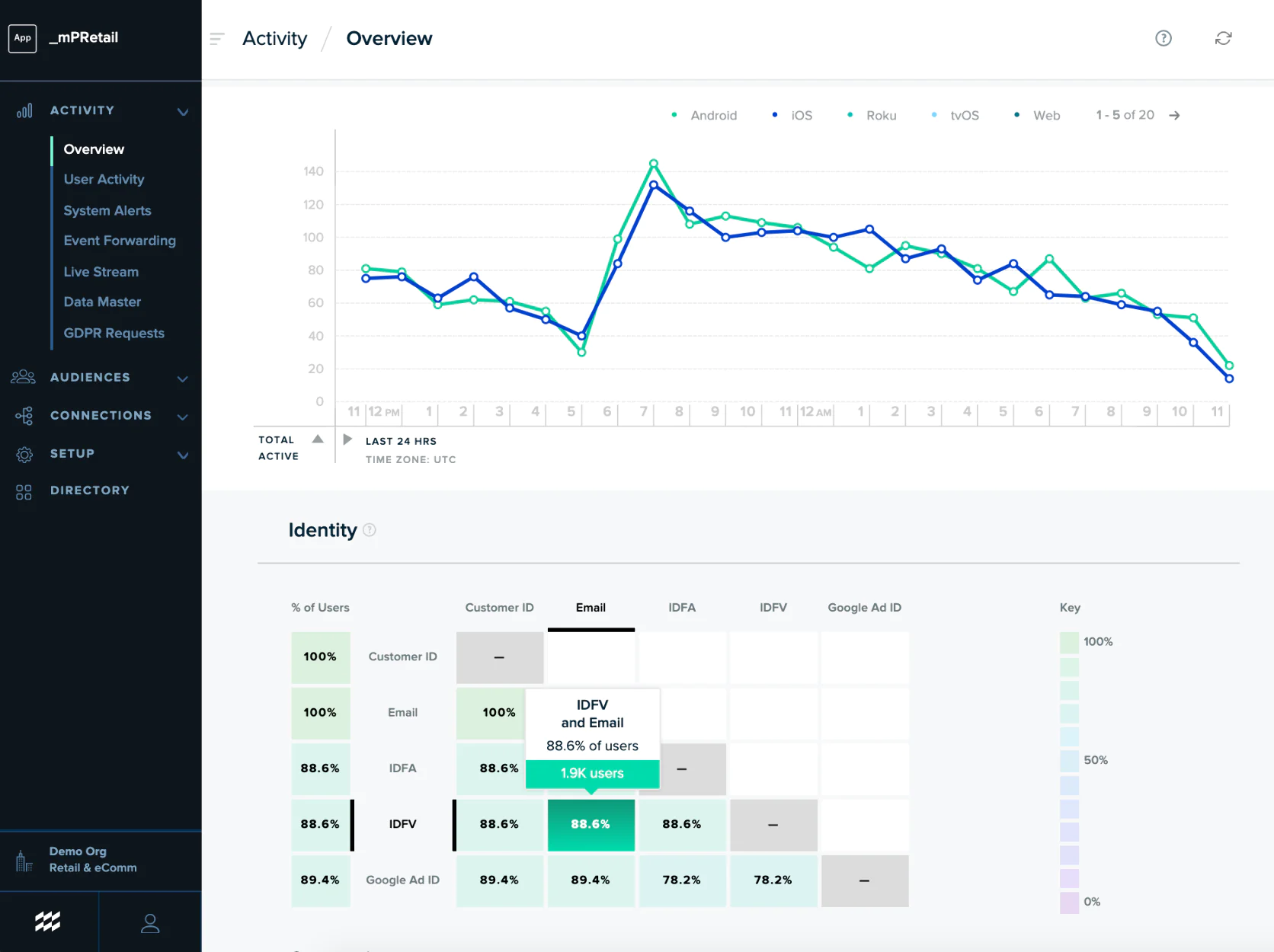
Audience overview in mPractice
It’s often described as a data pipeline and infrastructure tool rather than a marketing suite. If Tealium’s strength was web tagging originally, mParticle’s was mobile SDK integration—it’s used by many app-first businesses (think Spotify, Airbnb, etc.) to manage their in-app analytics and data flows. Over time, mParticle has evolved to cover web and other sources too, positioning itself as a strong enterprise-grade CDP alternative to Tealium with an emphasis on data quality and governance.
Key Features:
- Comprehensive SDKs and data integrations: mParticle offers SDKs for iOS, Android, web, OTT devices, and more. mParticle supports 300+ event integrations (called “Outputs”), including popular analytics, marketing, and data warehousing tools. It also has “Feeds” (inputs) to bring in data from sources like cloud marketing platforms or attribution services.
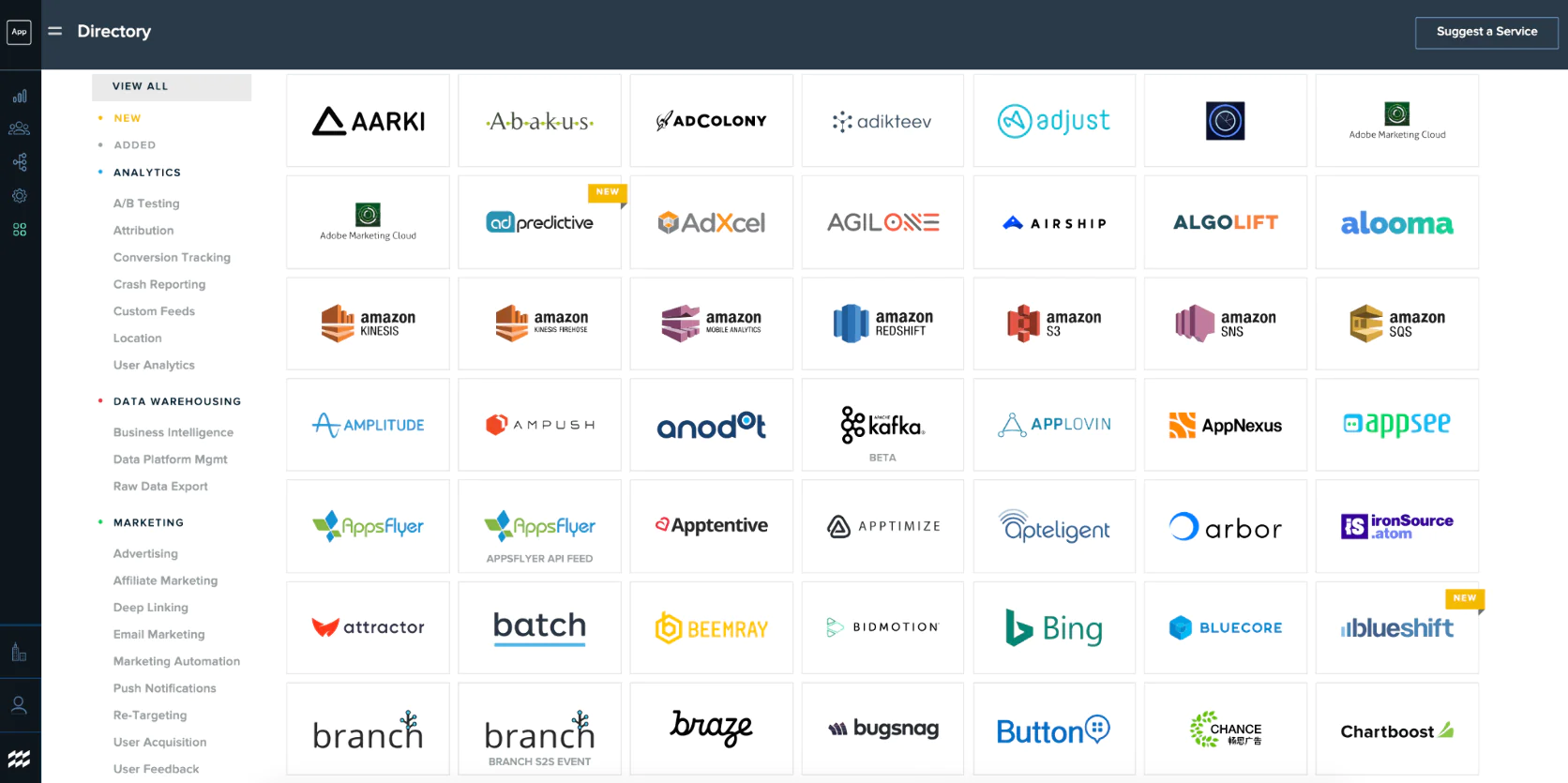
mParticle’s pre-built integrations
- Data quality & governance (Rules, Filtering, Privacy): One of mParticle’s standout features is the ability to enforce data quality and manage data flows precisely. You can set up Rules to block, transform, or synthesize events. There’s also a Live Stream view to monitor data in real time and troubleshooting. Privacy-wise, it can ingest consent flags and ensure compliance (like not forwarding data for users who opted out).
- User identity management: mParticle can maintain an ID graph for users, linking various identifiers (GAID, email, phone, etc.) to a unified customer identity. This helps coordinate data across devices and platforms. While its identity resolution might not be as elaborate as Tealium AudienceStream’s server-side profile stitching, it covers common use cases for merging anonymous to known users and recognizing returning users.
- Audience segmentation and syncing: mParticle allows creation of Audiences based on user attributes and events in the system (e.g., “users who have done X but not Y in the last 7 days”). These audiences update as new data comes in and can then be synced to marketing tools (like Facebook Custom Audiences, email providers, etc.). This is similar to Tealium’s audience functionality. Audiences.
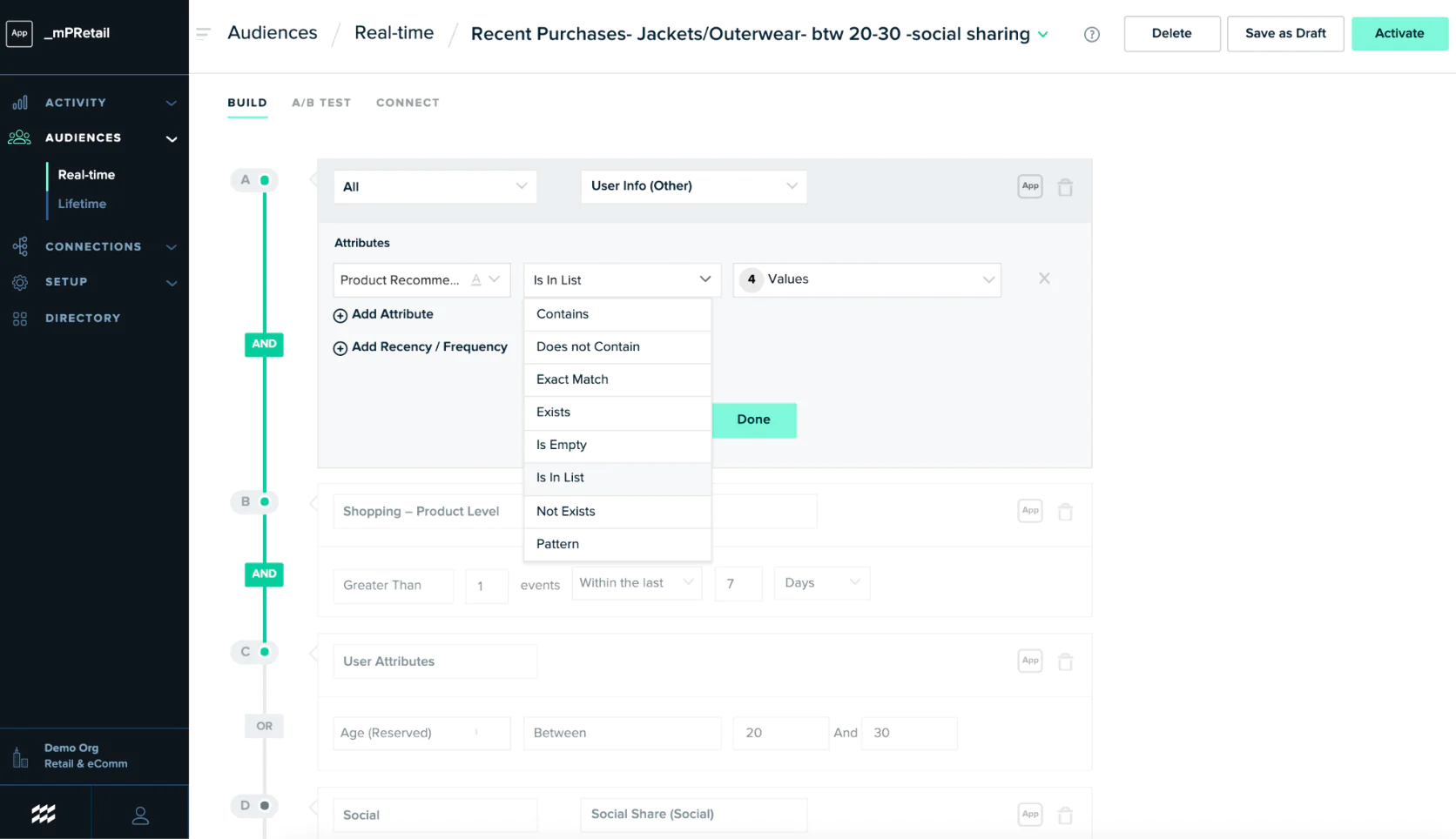
Creating a real-time audience in mParticle
- Developer-friendly and data-forward: mParticle provides robust APIs, a command-line interface, and supports Streaming to Data Warehouses (like forwarding raw events to Snowflake or BigQuery) for advanced analysis. This resonates with engineering teams who want access to the raw data for their own machine learning or SQL analysis beyond what the CDP UI provides. In short, it doesn’t silo your data—it helps distribute it even into your own databases.
Strengths and Weaknesses
mParticle’s key strength is control and flexibility in data handling, especially for mobile and cross-platform data. Many mobile app developers favor mParticle because it reduces the performance hit of having multiple SDKs—you integrate mParticle once, and it feeds many services (similar to Segment).

Creating a user prediction in mPractice
It’s very performant and light-weight, which matters for apps where every bit of size and speed counts. The data governance features are also top-tier. Companies concerned about sending the wrong data to the wrong place, or including sensitive info inadvertently, have peace of mind with mParticle’s filtering. Tealium has some filtering but mParticle really made it a centerpiece—the visual interface to allow or block event flows is intuitive, giving fine-grained control.
mParticle also excels in real-time stream processing. The Live Stream tool and debugging consoles are beloved by engineering teams to see data flows in real time, which can significantly cut down troubleshooting time.
Another strength is its focus on mobile and engagement data—for example, mParticle integrates well with push notification services, attribution partners (like Branch, AppsFlyer), and others that are crucial for mobile marketing. Tealium can integrate with those too, but mParticle often has deeper partnerships or slightly more off-the-shelf connectors in that realm, given its client base.
mParticle, like Segment, is not a full marketing execution platform. It doesn’t send emails, it doesn’t design multi-step journeys by itself. It’s more of a behind-the-scenes player. So marketers still need separate tools to act on the data.
Compared to Tealium AudienceStream, mParticle’s on-platform audience and profile capabilities are somewhat simpler. It’s largely about forwarding data, not storing rich historical profiles to the same degree. For instance, Tealium can store attribute aggregates (like “total purchases in last 90 days”) as part of a profile without external queries. mParticle tends to rely on either feeding that data to another system that calculates it or using computed traits feature (which it has, but less marketing-friendly to set up).
In essence, if you need a UI for non-technical users to derive new attributes and metrics, Tealium might be easier; mParticle might require some data engineering help to produce those and then ingest them.
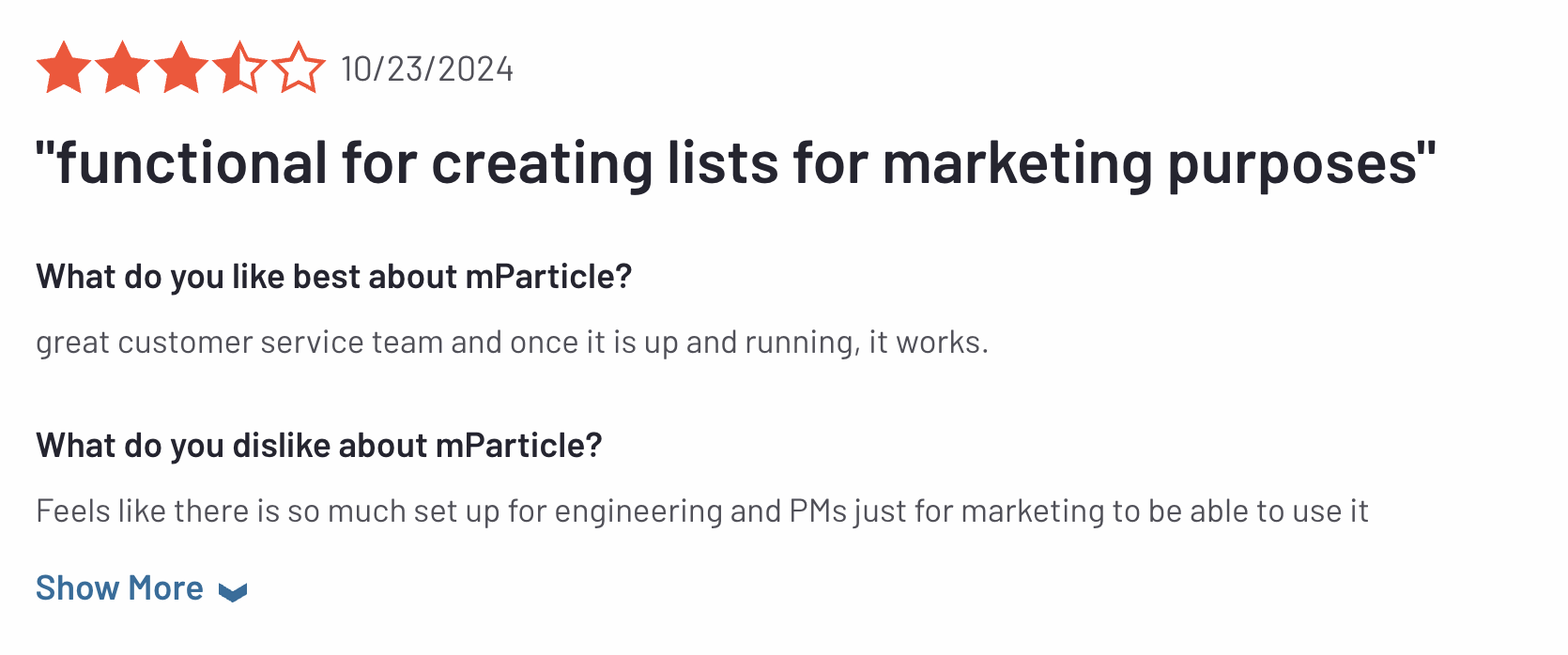
Another weakness is, as with many enterprise CDPs, cost and complexity scale with usage. mParticle’s pricing is usually based on event volume and number of MTUs (monthly active users), similar to Segment. It can get pricey at high scale (though it often is in line with Segment’s pricing).
Also, fully leveraging mParticle might require developer time—while it’s user-friendly for what it does, non-technical users might not utilize it alone; often an engineer sets up connections and a marketer just consumes the audiences. So it could be seen as more an “IT-driven CDP” versus Tealium which tried to cater more to marketing users in AudienceStream.
Compared to Tealium
mParticle and Tealium have overlapping functionality in data collection and distribution, but with nuanced differences:
mParticle’s heritage is mobile apps—its SDKs are optimized there. Tealium’s heritage is web tagging. Today, both do both, but if you ask around, mobile-first companies often pick mParticle, whereas some web-first companies are on Tealium. If your biggest concern is mobile app instrumentation and minimizing SDK bloat, mParticle is quite attractive.
Tealium has a marketer-friendly interface for building user segments and enrichment rules (no-code). mParticle’s interface, while polished, is more aimed at technical users managing data flows.
Both have extensive integration catalogs. Tealium possibly has more marketing-focused connectors (like direct to certain ESPs or loyalty platforms). mParticle has many too, plus strong analytics and measurement partner feeds (coming from mobile world: attribution, crash analytics, etc.). It’s rare to find a mainstream tool that one supports and the other doesn’t.
However, mParticle does emphasize its API and developer ecosystem—you can build custom integrations or use their Firehose API to consume all data. Tealium also has an API but is more often used via its UI.
Tealium offers a built-in consent manager for web that works with its tag management. mParticle doesn’t have a visible consent UI component like Tealium’s (since Tealium iQ can show a banner, etc.), but it does propagate consent status across the data pipeline. So if you rely on Tealium for cookie consent banners, that’s a separate thing to consider (mParticle might integrate with a consent manager rather than provide one).
Tealium AudienceStream processes data server-side and has a concept of “Edge” (doing some rule processing at collection point). mParticle is largely cloud-based routing; when events come in, they get processed in the cloud.
In summary, if your organization values developer efficiency, granular data control, and mobile prowess, mParticle is an excellent Tealium alternative. If you value marketer self-service in segmentation and a longer history in tag management, Tealium might edge out. For many larger companies, it could come down to who owns the CDP decision: engineering might advocate mParticle, marketing ops might advocate Tealium.
Compared to Maestra
mParticle compared to Maestra is similar to Segment vs Maestra discussion: they serve different purposes. mParticle is an under-the-hood data pipeline and CDP, Maestra is an all-in-one marketing engagement platform.
Using mParticle alone won’t run campaigns—you’d still need an email service, SMS service, etc., whereas Maestra includes those. So Maestra is a higher-level solution.
A key difference: time-to-market for marketing use cases. With Maestra, a marketing team can start building campaigns once initial integration is done. With mParticle, after integration, you then connect it to tools and those tools are where campaigns happen. It’s more plumbing than painting, to put it simply.
Scalability-wise, both can handle enterprise loads, but Maestra is typically adopted by mid-market/enterprise looking to unify stack, whereas mParticle is adopted by those looking to solidify their data infrastructure for an existing stack.
If a CMO is choosing, they might lean Maestra (“I want one system to personalize and message customers”). If a CTO or CPO (Chief Product Officer) is choosing, they might lean mParticle (“I want a single pipeline to manage customer data across our product and marketing systems”).
For an e-commerce brand specifically, Maestra offers a lot of built-in commerce logic (product catalogs, loyalty, etc.), which mParticle doesn’t have—it would just carry that data if you connect it. So Maestra is more solution-oriented for retail, while mParticle is more tool-oriented.
In essence, Maestra vs mParticle is tools to execute marketing vs tools to enable marketing execution. A company with a robust marketing ops team might love mParticle feeding their multiple specialized tools (best-in-class approach). A company that wants to simplify and have one central system might prefer Maestra.
Tool #7: Bloomreach Engagement (Exponea)
Best Tealium alternative for commerce-focused personalization and marketing
Bloomreach Engagement (formerly Exponea, which Bloomreach acquired) is a customer data and experience platform tailored to e‑commerce and retail brands. It combines a CDP with marketing automation, similar in spirit to Maestra’s all‑in‑one approach, and is particularly known for its AI‑driven product recommendations and marketing capabilities.
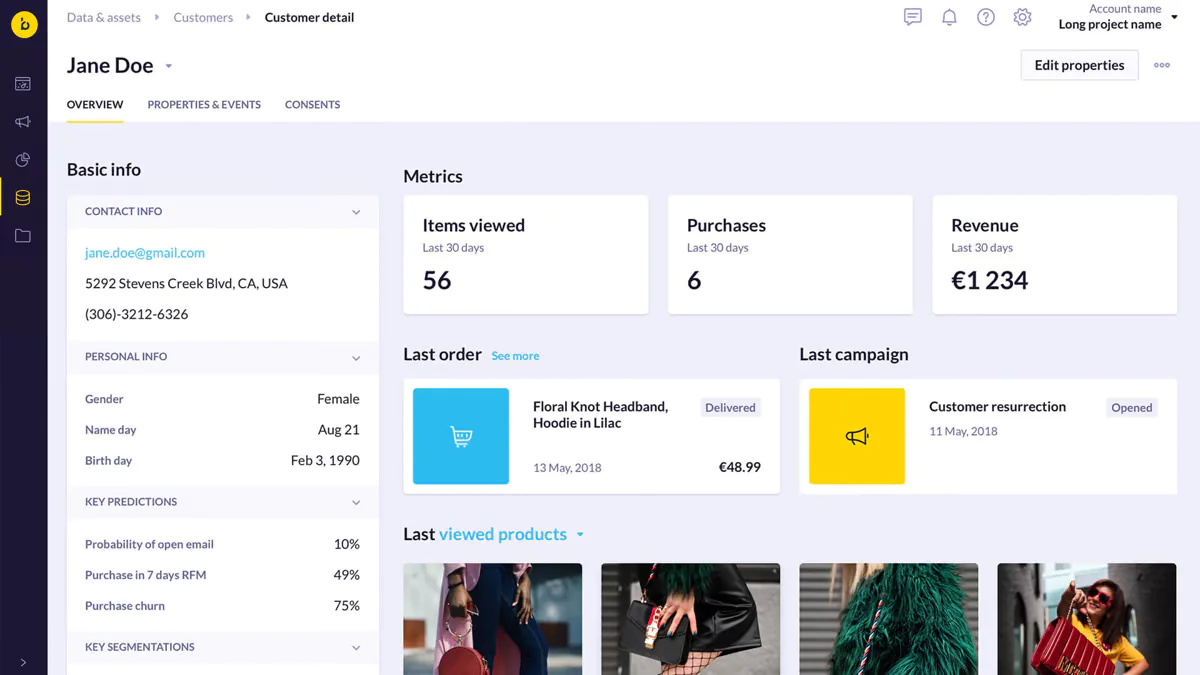
Customer’s profile in Bloomreach
If you’re looking at Tealium primarily to fuel personalized marketing for an online store, Bloomreach Engagement is a compelling alternative that can not only unify data but also drive campaigns. It sits in the broader Bloomreach suite alongside Discovery (product search/merchandising) and Content (CMS), focusing on lifecycle marketing and CRM for commerce.
Key Features:
- Unified customer profiles with purchase history: Bloomreach Engagement ingests data from your website, mobile app, CRM, and other sources to build a 360° profile. For retailers, this means combining browsing behavior, product views, cart events, and purchase transactions into one timeline for each customer. It performs identity stitching between anonymous visits and known customers (e.g., post‑login or via email capture).
- Segmentation and AI scoring: Users can create segments with a rich filter system. Beyond manual segments, the platform provides AI‑driven scoring—like predicting which customers are likely to convert or churn based on myriad factors.
- Omnichannel campaign orchestration: Bloomreach has a visual campaign/journey builder where you can design scenarios. Essentially, it’s a full marketing automation tool tied directly to its CDP. So unlike Tealium, which would send data to an external email system, Bloomreach is the email/SMS system for many clients.
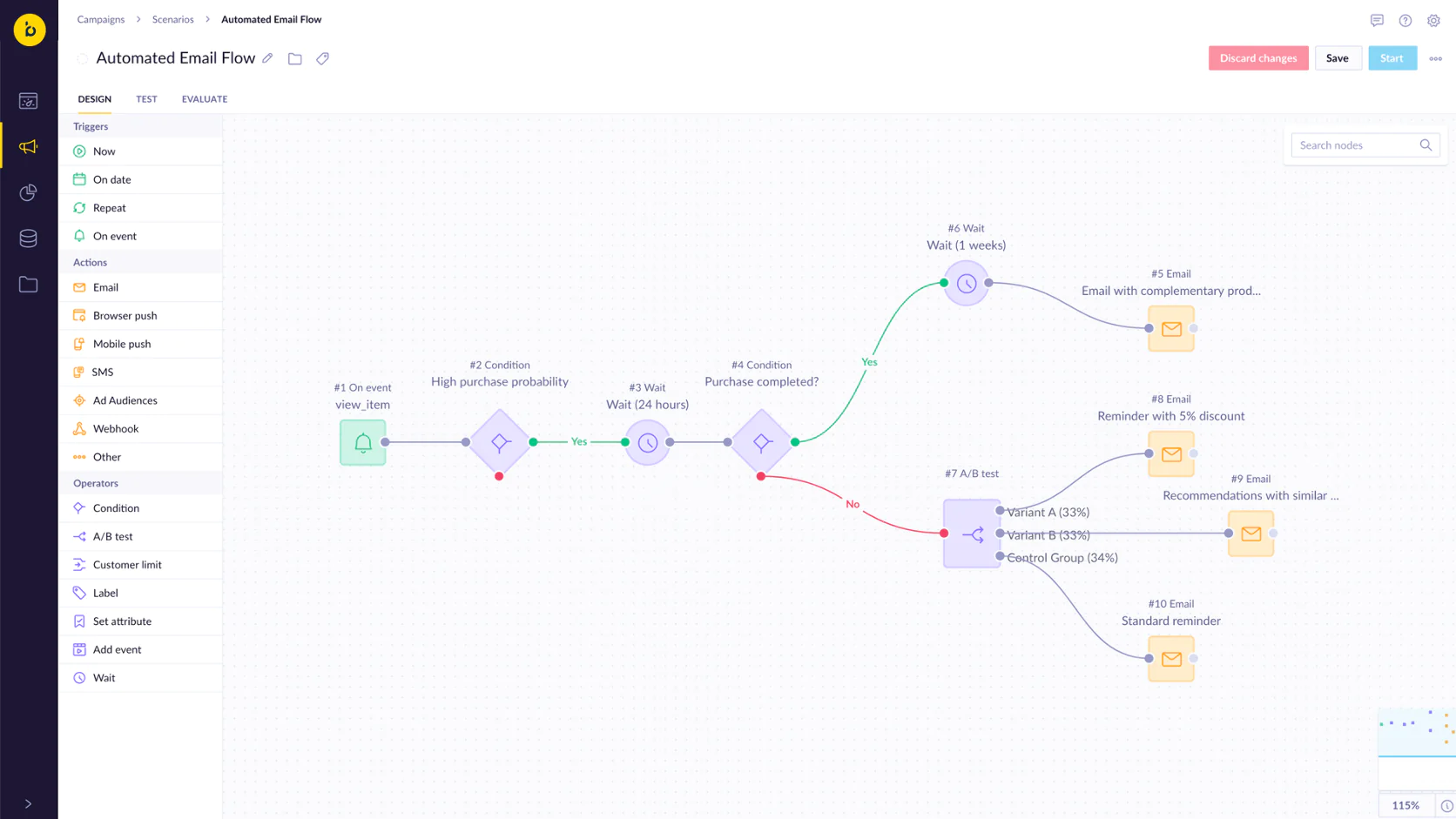
Bloomreach’s flow builder
- AI‑driven product recommendations and personalization: One of Bloomreach’s fortes is using AI and machine learning to personalize content, particularly product recommendations. It can generate personalized product feeds for emails or web, “recommended for you” sections, and even optimize the sort order of products for each user. These models consider user behavior, product attributes, and overall trends.
- Built‑in marketing channels: Bloomreach Engagement includes an email editor and sender (so you can design and send emails directly), SMS sending, push notifications, in‑app messaging, and even web layers (pop‑ups or banners on your site). This means you can execute campaigns without exporting segments to external tools—much like Maestra, it’s an all‑in‑one.
- Analytics and reporting: The platform offers dashboards and reports on campaign performance, revenue attribution, funnel dropout, and customer lifetime value. It can do cohort analysis (e.g., how various segments behave over time) and even some product analytics (e.g., which product categories are trending in engagement or revenue). The analytics are commerce‑centric—things like average order value by segment, retention rates, etc., are readily available. This is beyond what Tealium would provide natively.
Strengths and Weaknesses
Bloomreach Engagement’s key strength is combining rich customer data with actionability tailored to retailers. It’s essentially a CRM+marketing brain for e‑commerce. For teams that might otherwise stitch together Tealium, an email service, a personalization engine, and an analytics tool, Bloomreach offers a unified solution.
Users praise its powerful segmentation and personalization—the AI recommendations and triggered emails often drive significant uplift in conversion and retention, which is Bloomreach’s big selling point.
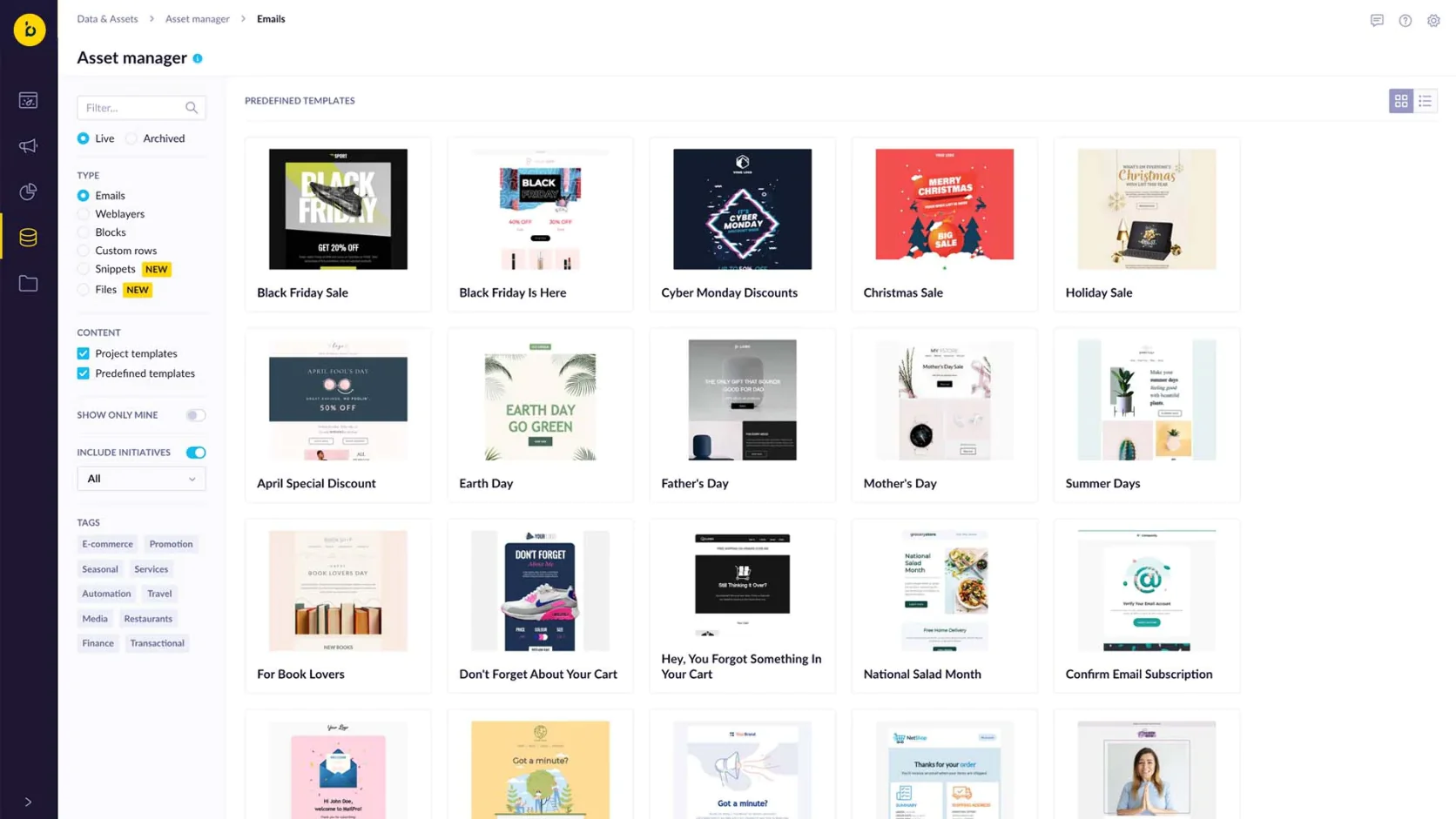
Bloomreach’s asset manager
Another strength is speed to market for retail use cases. Bloomreach (Exponea) was known for rapid deployment of campaigns like cart recovery, price‑drop alerts, back‑in‑stock notifications, etc. Many of these are available as pre‑built scenarios that you can tweak.
So, compared to implementing Tealium and then coding custom triggers and hooking up an email tool, Bloomreach might let you launch a cart abandonment email sequence with personalized product content in a very short time.
Additionally, Bloomreach’s user interface is relatively friendly for marketers. It balances advanced capabilities with a clear UI for building segments and campaigns. Marketers who may have felt Tealium is too data‑centric or technical often find tools like Bloomreach easier to directly utilize for end‑to‑end campaigns.
One weakness to notice is data openness—historically, some all‑in‑one platforms were seen as more closed. Bloomreach Engagement does allow exporting data and has APIs, but companies with heavy custom BI or data science practices might still prefer to mirror the data in their own warehouse for analysis. Tealium, being focused solely on data, perhaps integrates a bit more neutrally with external analysis pipelines.
Cost and fit: Bloomreach is typically aimed at mid‑market to enterprise e‑commerce brands. Its pricing is usually tiered by customer count or volume of events, and often comes as part of a larger Bloomreach deal if you also use their search or CMS. It may be expensive for smaller companies (similar to Tealium in that regard).
If a company just wants a CDP to centralize data and intends to keep using separate best‑in‑class email/push tools, then a neutral CDP like Tealium or Segment might be more to the point. Bloomreach is strongest when you use both its data and its engagement capabilities together.
Compared to Tealium
Bloomreach Engagement vs Tealium is essentially all‑in‑one marketing platform vs pure CDP. If you were considering Tealium to improve personalization and campaign targeting for your online store, Bloomreach says: why not let me handle both data and campaigns? The main differences:
Tealium serves all industries and requires you to build retail‑specific logic yourself. Bloomreach comes with that focus—e.g., it knows what a product catalog is, what a cart event means, and has pre‑built tactics for those. It even has a visual merchandising interface (from the Bloomreach Discovery side) that can tie in—e.g., marketers can coordinate product promotions in search with campaigns. Tealium doesn’t have any concept of product catalogs or merchandising out‑of‑the‑box.
Bloomreach can be easier and faster to get marketing results because less integration is needed. However, Tealium might fit into a complex existing stack more flexibly. For instance, if you already have a favorite email service, Tealium will happily feed it. Bloomreach would either replace that email service or you’d not use Bloomreach’s email at all (losing some value).
Tealium AudienceStream is very powerful in creating data enrichment rules (like tallying events, making badges for certain behaviors, etc.) and then those can be used anywhere. Bloomreach also allows computed attributes and uses AI to enrich profiles. They’re comparable here, but Tealium might offer more “raw data” philosophy (it collects everything and leaves a lot open‑ended), whereas Bloomreach, while flexible, nudges you towards use cases it excels at (and might abstract some raw data details behind its AI/automation).
In many RFPs, Bloomreach (Exponea) and Tealium would actually be seen as different categories: one is a “Campaign CDP”, the other a “Data CDP”. If your primary goal is to run sophisticated marketing campaigns and you welcome a new platform for that, Bloomreach is attractive. If your goal is strictly to unify data and feed it to an existing marketing setup, Tealium could be more straightforward.
Compared to Maestra
Bloomreach Engagement and Maestra are quite similar in concept—both aim to unify data and channels in one. Both offer real‑time CDP, omnichannel campaign orchestration, and loyalty/CRM features.
Key differences might come down to specific features and approach. Maestra, for instance, offers an included loyalty program module and paid media optimization, whereas Bloomreach emphasizes AI product discovery and its integration with the on‑site search/merchandising experience (through its Discovery product).
Both are strong in email/SMS/push—with templates, journey builders, etc. Maestra might offer more hands‑on strategic support by default (with the dedicated CSM model). Bloomreach, while it has customer success too, often works through integration partners for implementation.
For a company deciding between these two, it could come down to fit and rapport—the nuances of each platform’s capabilities relative to your needs, and the kind of support/partnership each vendor provides. They are more similar than different in the grand scheme (especially when both are compared to a pure CDP like Tealium).
In summary, both Bloomreach and Maestra deliver on the vision of “CDP plus omnichannel execution”.
Tool #8: Insider
Best Tealium alternative for AI-powered multichannel personalization at scale
Insider is a cross‑channel customer engagement platform focused on delivering personalized experiences across a wide range of channels—from web and mobile to messaging apps and email.
Originating from an AI‑driven personalization background, Insider has grown into a unified platform that includes a CDP, predictive segmentation, and a multichannel campaign orchestrator.

Insider’s customer profile
If Tealium’s role in your stack would be to feed personalization and messaging tools with data, Insider presents an enticing alternative: it brings the data platform and the engagement channels together, especially excelling in channels like mobile push, web push, and emerging messaging apps.
It’s used by many large global brands (particularly in retail, travel, and automotive) for its strength in creating cohesive, personalized customer journeys.
Key Features:
- Unified customer data platform: Insider unifies data from websites, apps, and other sources into a single customer view, similar to other CDPs. It addresses data silos by offering a 360° profile that can be used for targeting. This includes both historical behaviors and real‑time events.
- AI‑driven segmentation and predictions: Insider provides a suite of predictive scores out‑of‑the‑box—likelihood to purchase, churn risk, predicted revenue, etc., computed by its AI models on your data. It also allows building segments using these predictions plus any behavior or attribute (e.g., “high churn risk users who browsed category X”). The AI can also auto‑discover segments (like clusters of users) which can reveal patterns marketers might not have seen manually.
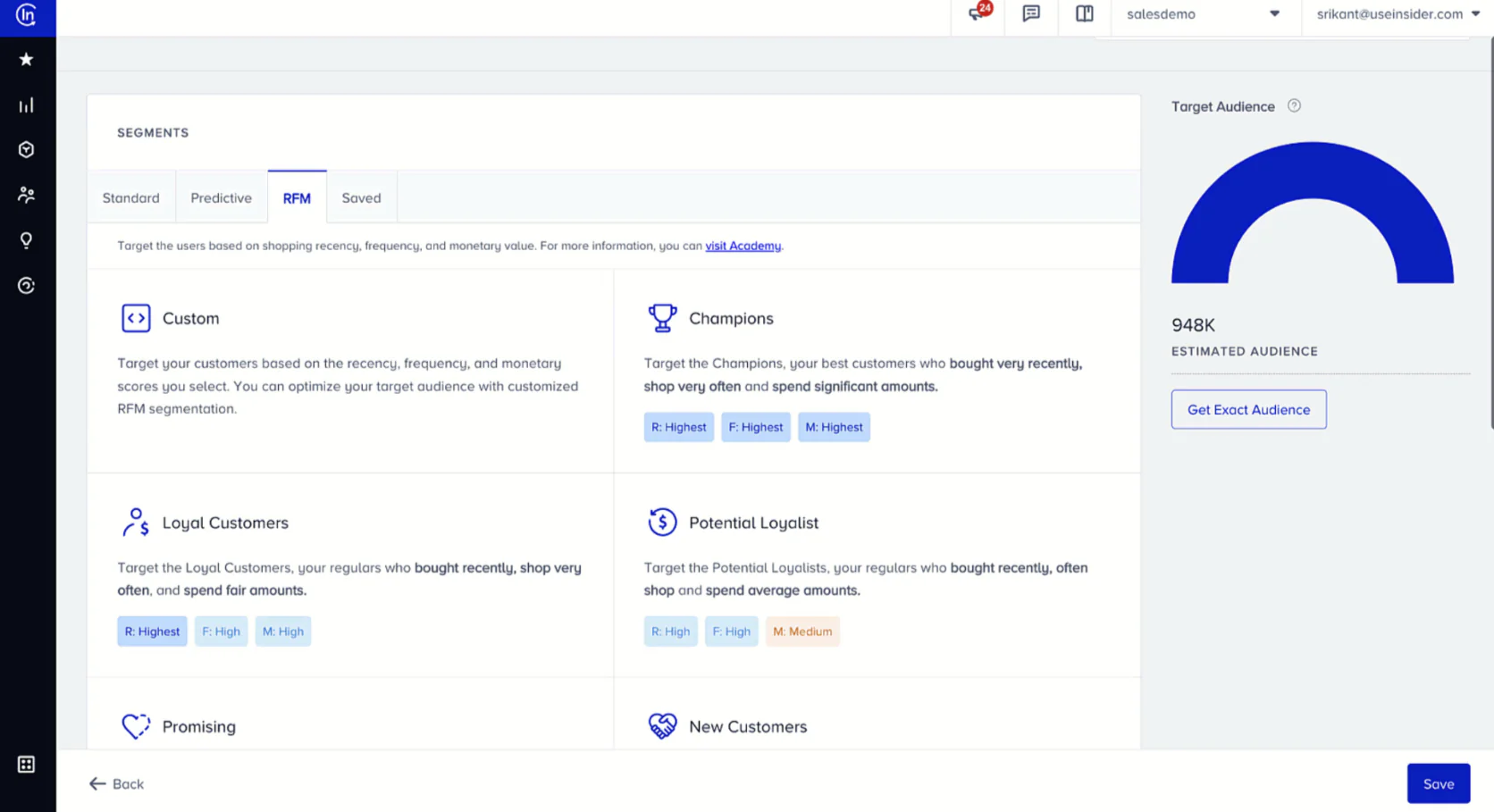
Insider’s segmentation
- +12 integrated channels with journey orchestration: This is where Insider shines uniquely. It supports not just email and SMS, but also web push notifications, mobile app push notifications, in‑app messages, web personalization, on‑site recommendation widgets, Facebook/Google Ads retargeting, WhatsApp messages, Facebook Messenger, RCS, even tactile channels like browser inbox messages. Via its Journey Orchestration (Architect), you can design campaigns that move across these channels.
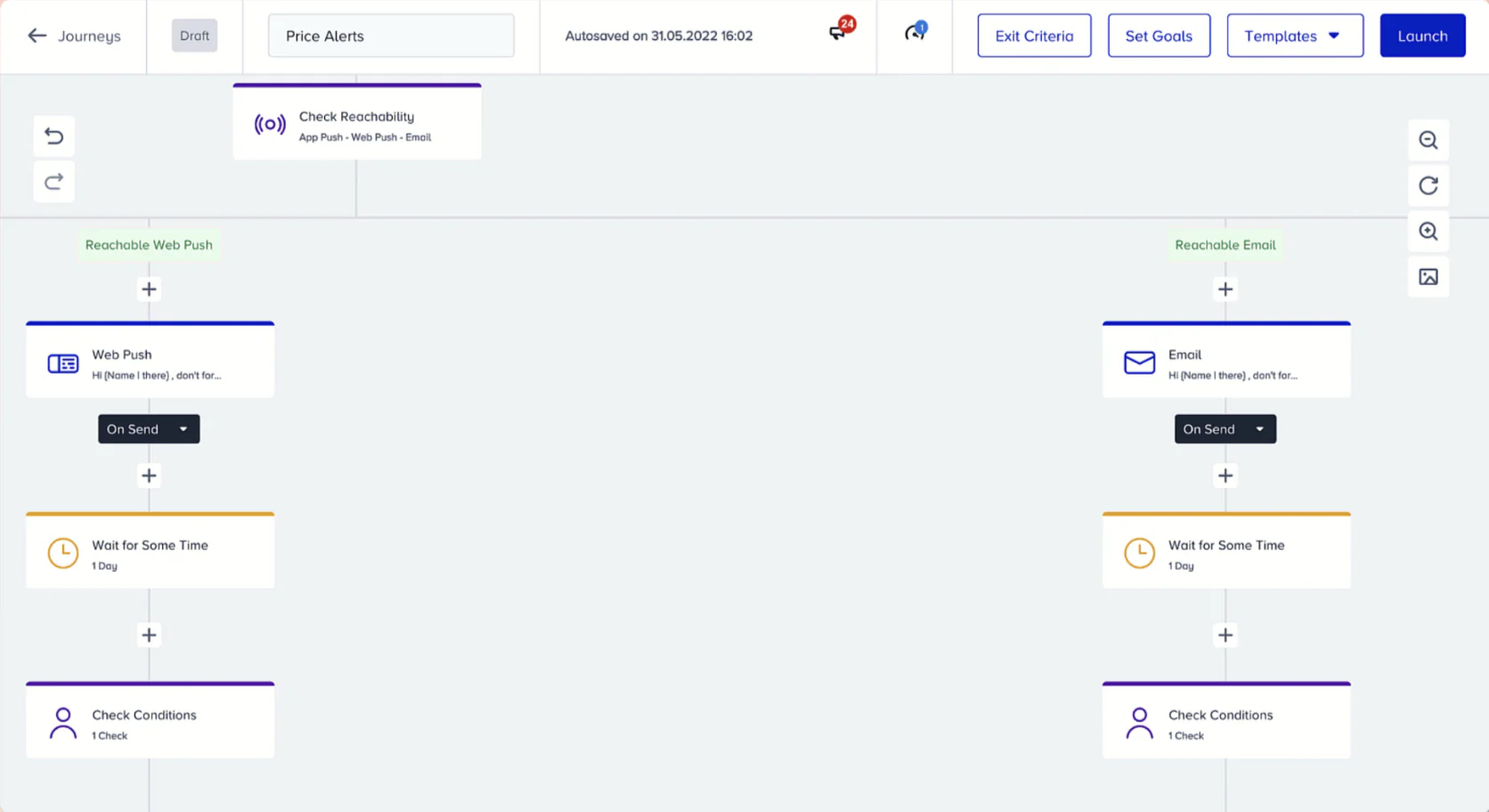
Insider’s flow builder
- InStory and immersive content: A unique feature Insider offers is InStory—essentially the ability to create Instagram‑like story content modules on your own app or site. This is an example of the kind of innovative engagement tools Insider includes. It allows brands to repurpose that familiar “story” format to engage users with tappable, full‑screen visuals on their own channels.
- On‑site personalization and recommendations: Insider provides personalization widgets for web and mobile. This includes product recommendations, personalized content blocks, and even personalized website UX (like rearranging elements, showing different homepage banners by segment, etc.). These can be configured via Insider’s WYSIWYG editor without coding.
- Integration Hub and API flexibility: While Insider encourages you to use all channels within it, it’s also aware you might have existing tools. It has an Integration Hub with out‑of‑the‑box connectors to common systems (e.g., e‑commerce platforms like Shopify or Magento, CRMs like Salesforce, analytics like Google Analytics, ad platforms, etc.).
Strengths and Weaknesses
Insider’s biggest strength is multichannel richness and agility. It covers channels that other platforms often neglect, especially messaging apps and newer engagement channels. For brands targeting younger demographics or markets where apps like WhatsApp are key, this is a huge plus—you can orchestrate WhatsApp campaigns with the same platform that handles your email and web, ensuring consistent messaging and easier coordination.
Another strength is strong mobile focus. Features like app push, in‑app modals, and even app inbox (a message center in your app) are well‑developed. Tealium by itself doesn’t deliver any push or in‑app message—you’d need another tool for that—whereas Insider includes it.
Insider also offers marketer‑friendly AI. The predictive segments and recommendations are usable without needing a data scientist on staff. Many customers praise how easily they can leverage the AI insights (like using a “likely to convert” score to narrow an audience)—whereas with a raw CDP like Tealium, you’d have to import such scores from an external AI system if you have one.

Insider’s reporting
Additionally, Insider prides itself on client support. They often provide a dedicated success team (somewhat like Maestra’s model) who actively helps plan and optimize campaigns. Many references speak of Insider more as a partner than a tool—their team often helps create story content, optimize journeys, etc.
Insider’s breadth can introduce a learning curve. There are a lot of channels and capabilities; some users need time to master everything (though you can start simple and expand).

And like most others in this space, pricing is on the higher side (enterprise‑level), usually custom quotes based on usage. It’s generally not aimed at small businesses; mid‑size to large businesses with multi‑channel presence see the most value.
Finally, if a company is not interested in certain channels (say they don’t use WhatsApp or mobile app at all), part of Insider’s differentiation might be less relevant—it could be more horsepower than needed if you only plan to use email and web personalization, for example (where competitors like Braze or Bloomreach could equally serve).
Compared to Tealium
Insider versus Tealium is engagement hub vs data hub. With Tealium, you’d use it to send data to, say, Braze for push notifications, to an email service for emails, to an on‑site personalization engine for web, etc. With Insider, one platform handles those engagements directly.
In terms of channels: Tealium’s connectors include email, ad platforms, maybe SMS via Twilio, etc., but it doesn’t have native connectors for things like WhatsApp or Messenger—you’d have to send data to a system that does those, or build integration. Insider has those channels native.
Tealium’s strength is neutrality—if you already have investments in, say, Oracle Responsys for emails and a separate push vendor, you could keep them and just feed them better with Tealium. Insider’s strength is offering possibly a more modern, integrated alternative to those disparate systems.
Data‑wise, Tealium might allow more bespoke data manipulations via its rule engine and attributes (especially for e‑commerce specifics, though Insider does allow custom attributes and event triggers too). But Tealium won’t do anything with the data unless you connect an action; Insider will proactively use data (like trigger a web personalization) as part of its built‑in capability.
Comparison summary: If your priority is real‑time personalized engagement across many channels and you’re open to a unified platform, Insider can replace Tealium + several tools. If your priority is to improve your data foundation while keeping existing marketing tools, Tealium is a cleaner choice.
Compared to Maestra
Insider and Maestra are often mentioned in the same breath—both aim to be the central platform for multi‑channel marketing, with CDP at their core. They have very similar channel support (email, SMS, push, web, etc.). However, there are some differences in emphasis:
Both Insider and Maestra are notably strong on messaging apps and newer channels (like WhatsApp, in‑app messages, etc.). But Maestra includes a loyalty and promotions engine out‑of‑the‑box, which Insider lacks as a built‑in module. Insider can run loyalty campaigns, but the actual points system or loyalty program logic would typically reside elsewhere or need to be set up via Insider’s journey logic.
Both offer AI‑driven personalization. Insider markets heavily its AI for predicting the best channel and time for each customer (to send messages when and where they’re most likely to engage—something called Auto‑Optimize). Maestra’s AI is more around product recommendations.
Insider is a larger company globally (especially strong in Europe, Asia, and growing in North America), with on‑ground support in many countries. Maestra is newer, focused on North America. Depending on where your operations are, one might have a more local presence.
Insider’s experience with large global deployments (it cites clients like Samsung, Carrefour, etc.) might give enterprises confidence. Maestra’s boutique approach (with a dedicated CSM for every client) might give other companies a comfort of high‑touch support too. It’s a bit about preference: a big global team vs a focused partnership model—both can yield great support, just delivered differently.
Cost could also be a factor—both are premium, but pricing models might differ (Insider often custom quotes based on channels and usage; Maestra has that flat starting price point, which might scale with usage too).
One could imagine using either as the central brain of marketing. If you lean a bit more towards expanding into emerging channels and maybe have complex regional messaging needs, Insider might be compelling.
If you lean more towards integrating loyalty and on‑site merchandising closely with campaigns, Maestra might have a slight edge. Both will handle email, SMS, personalization, etc., very well.
Tool #9: ActionIQ
Best Tealium alternative for enterprise-scale segmentation and analytics (composable CDP)
ActionIQ is an enterprise CDP known for its strength in enabling marketers to access and segment customer data from complex, large-scale data environments. Often labeled as a “composable CDP” or a data warehouse-centric CDP, ActionIQ is built to work with your existing data infrastructure (like data lakes and warehouses) rather than store all data itself.
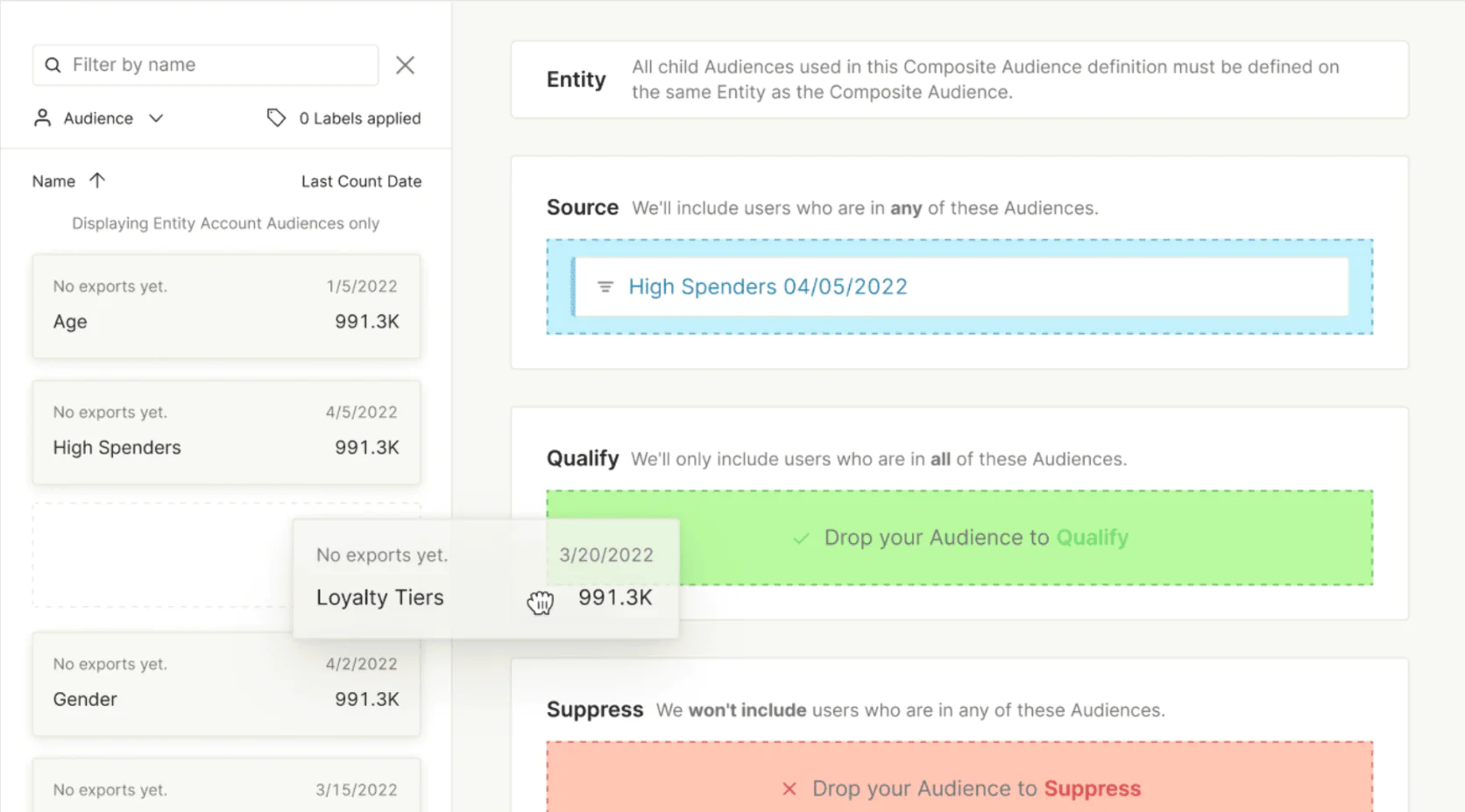
ActionIQ’s Audience Center
Its sweet spot is large organizations with tons of customer data spread across multiple systems — it creates a layer on top that lets you unify that data for marketing and analytics without re‑architecting everything. If Tealium is a bit of a black‑box data store, ActionIQ prides itself on connecting to your data and giving business users a way to exploit it.
It’s a popular choice for media, telecom, financial services, and retail companies that have strong data teams and want a marketer‑friendly interface to their big data.
Key Features:
- Data agnostic architecture: ActionIQ doesn’t force you to bring all your data into it. Instead, it connects to various sources – data warehouses (Snowflake, BigQuery, Redshift), cloud storage, CRM systems, etc. – and virtually unifies profiles. It will ingest and index some data for performance, but it’s flexible on where the single source of truth lives.
- User-friendly audience builder: ActionIQ provides a UI for non‑technical users (typically marketing or analytics teams) to build segments and analytics queries by dragging and dropping attributes and events. You can define complex logic (funnels, sequences, time windows) without SQL. Under the hood, it translates these into queries against your big data.
- Customer profiles and journey context: ActionIQ creates unified profiles by merging identifiers. One nifty feature: it allows not just point‑in‑time segmentation but also multistep journey querying – for example, “Customers who did X, then within 7 days did Y, but never did Z afterwards.”
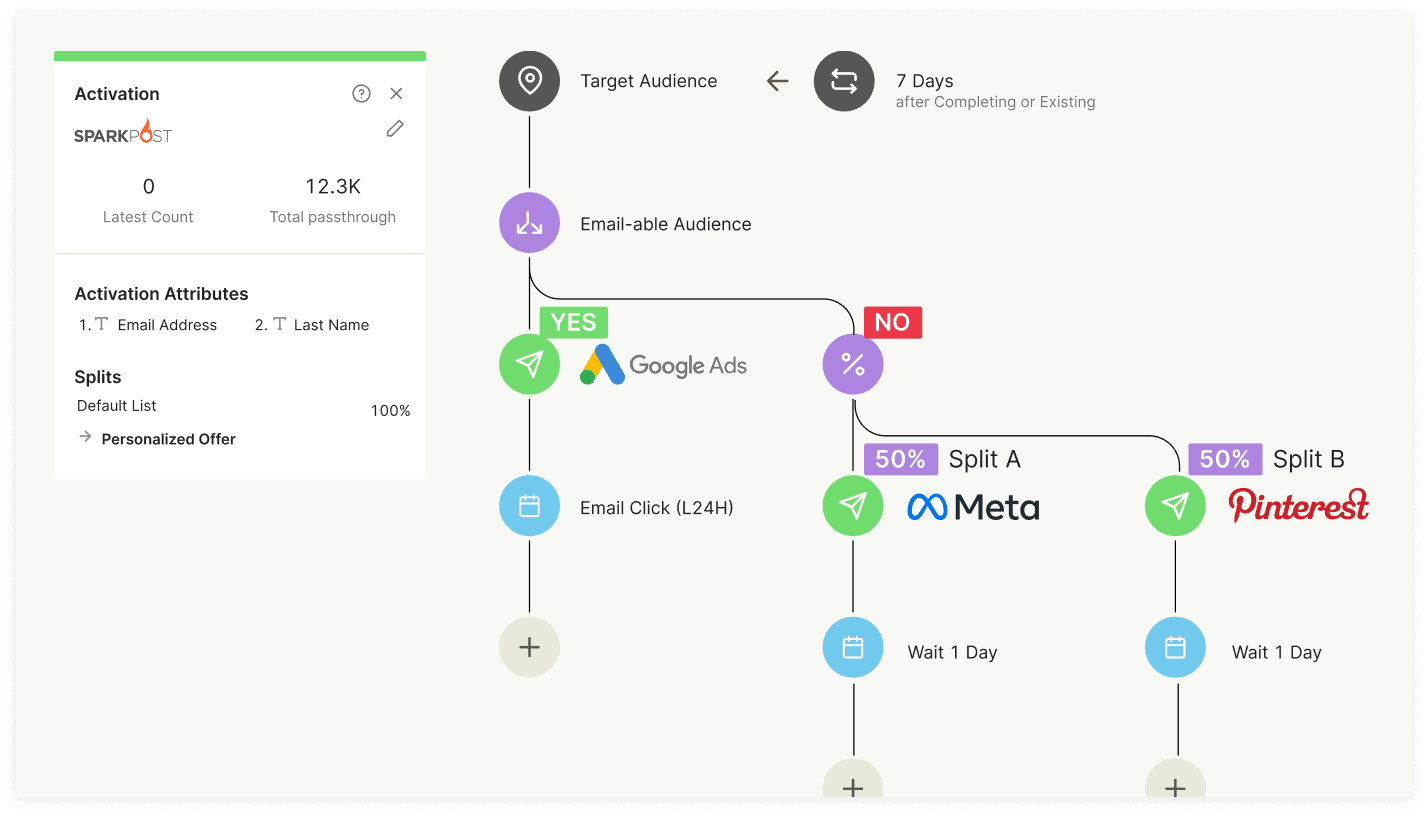
Building flows in ActionIQ
- Audience activation and integrations: Once you have an audience, you can push it to numerous destinations – email platforms, ad platforms, cloud storage, etc. Its real‑time module can also stream segment membership to trigger systems for immediate personalization.
- Governance and security: ActionIQ offers robust role‑based access control, so different users can be limited to see only certain data or fields. It also emphasizes that data never leaves your secure environment in some deployment modes – mitigating risk.
- Composable infrastructure: Because ActionIQ sits atop your data, it plays nicely with your BI tools and AI workflows, allowing marketers and analysts to collaborate on shared definitions.
Strengths and Weaknesses
ActionIQ’s strength is in enabling enterprise marketers to harness big data without bottlenecks. Companies with billions of events or very siloed data appreciate that they don’t have to pipe all that into a new system. Instead, ActionIQ leverages what’s there.
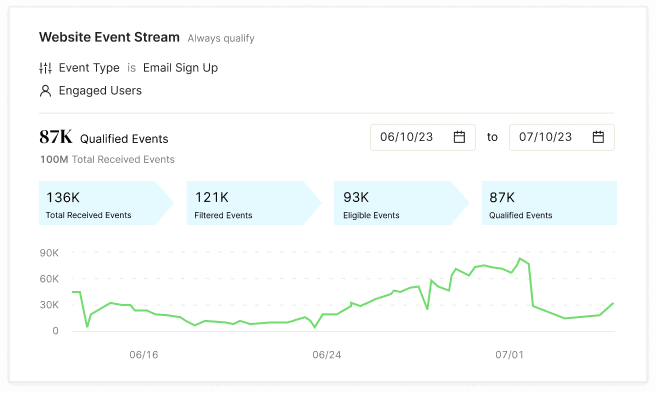
Data monitoring in ActionIQ
Its interface is known to be powerful – marketers can segment on practically any attribute combination and get results in minutes on huge datasets. This scalability opens up sophisticated targeting that previously might require a data scientist.
Another strength is collaboration between IT and marketing. ActionIQ integrates with IT’s databases and adheres to their security practices, while giving marketing a point‑and‑click experience. This bridging function is pivotal in many enterprises.
Because ActionIQ often relies on connecting to your data, it can be complex to implement. If a company doesn’t have a clean data repository, they might have to invest in data prep to feed ActionIQ, whereas a tool like Tealium might just start collecting fresh data via tags right away.
ActionIQ by itself doesn’t execute campaigns; you still need the email platform, ad platform, etc. It’s more comparable to Tealium in that sense. Historically it was more batch‑oriented, so some ultra‑real‑time use cases may require additional setup.
Compared to Tealium
ActionIQ and Tealium can actually complement each other, but if choosing one:
Tealium’s forte is real‑time event processing and on‑site triggers, while ActionIQ’s forte is deep analytics and batch segmentation on huge datasets.
Tealium creates its own cloud repository; ActionIQ sits on top of your data warehouse. Tealium empowers marketers to set up immediate triggers; ActionIQ empowers them to explore complex sequences and leverage months or years of data.
In simpler terms, choose Tealium if you need to react instantly to behaviors across channels. Choose ActionIQ if your challenge is making sense of vast historical data and enabling marketers to self‑serve sophisticated segments.
Compared to Maestra
ActionIQ vs Maestra is a contrast of data‑centric CDP vs campaign‑centric CDP. ActionIQ won’t send an email or SMS; Maestra will. ActionIQ requires pairing with marketing execution tools; Maestra includes them.
Maestra will deliver value faster for campaign execution because it doesn’t require additional integrations for outbound channels. ActionIQ may take longer but offers unrivaled analytical depth on your existing data.
In essence, choose ActionIQ if you have a complex data environment and want a CDP that molds to it, giving marketers powerful segmentation on all that data, and you’re okay continuing to use separate channels/tools for delivery.
Choose Maestra if you prefer a unified tool that not only unifies data but also natively reaches out to customers across channels, even if that means consolidating your stack around it.
Tool #10: BlueConic
Best Tealium alternative for marketer-managed unified profiles and quick personalization
BlueConic is a pure-play CDP that focuses on simplicity and usability for marketing teams. It’s often the choice for mid-market brands or divisions of enterprises that want to get a customer 360 and personalization off the ground quickly without heavy IT dependence.
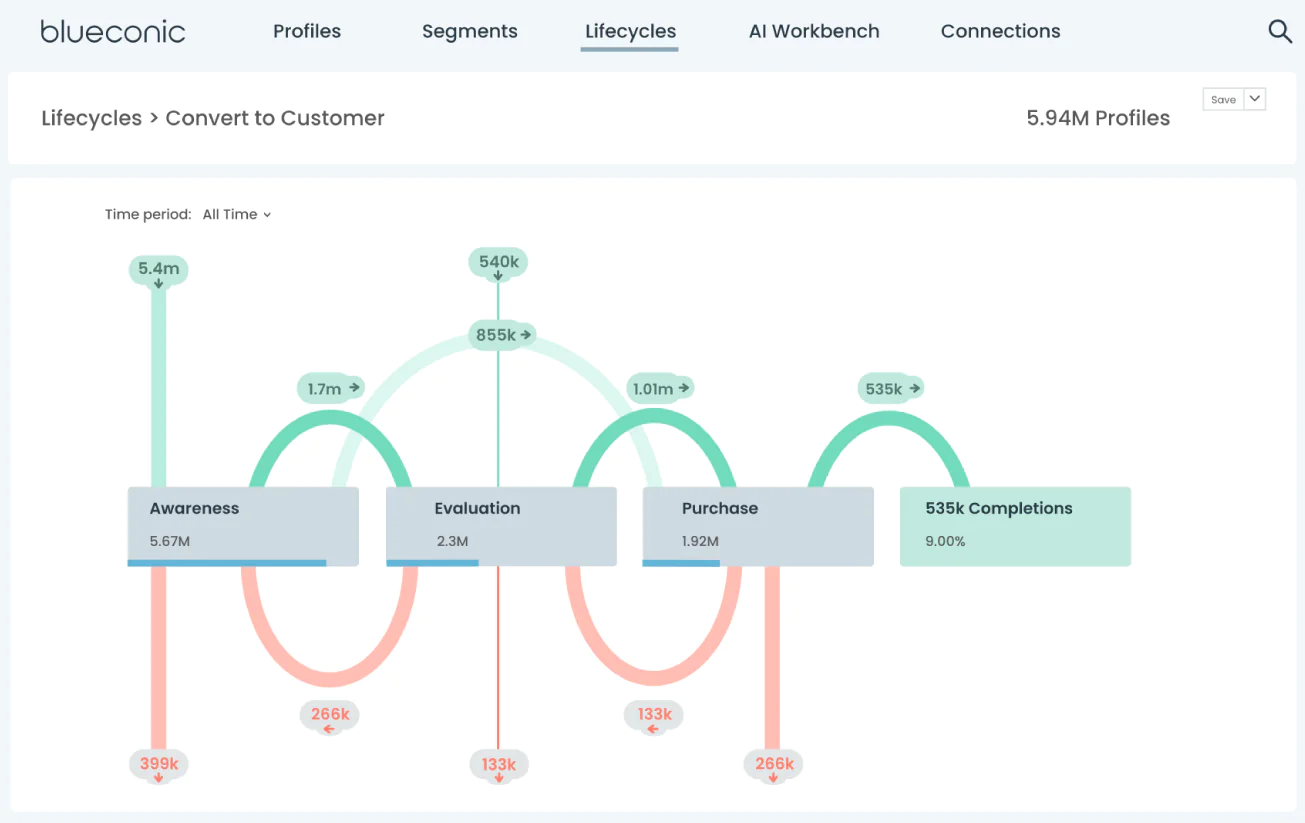
Customer lifecycle overview in Blueconic
BlueConic provides a unified view of customers and easy ways to activate that data through lightweight personalization, segmentation, and data syncs. If Tealium seems too technical or overkill for your needs, BlueConic might appear as a more accessible alternative that still gives you the core CDP benefits. Think of BlueConic as a “CDP for doers”—its mantra is often turning data into actionable growth with an interface that non-tech users can handle day-to-day.
Key Features:
- Real-time customer profiles: BlueConic builds a profile for each individual by stitching data from various channels (web, email, CRM, etc.) in real time. Profiles are updated progressively—as a visitor engages on your site or opens an email, their profile gains new attributes immediately. These profiles can include demographic info, preferences, consent status, and behavioral scores.
- Predictive scoring and machine learning: BlueConic offers a feature called AI Workbench, which allows users (or data analysts) to run machine learning models using the data in BlueConic’s profiles. Additionally, BlueConic has some out-of-the-box predictive models (similar to Insider or Bloomreach) that can be configured with minimal effort, turning raw data into predictive insights (like likelihood to convert) that marketers can readily use.
- Segment creation and activation: Creating segments (audiences) in BlueConic is straightforward via a point-and-click interface. You can mix and match profile attributes and behaviors to define who you want to target. Once defined, these segments update automatically as profiles change. Now, to activate those segments, BlueConic has a variety of connectors—for example, sending a segment to Facebook Custom Audiences, Google Ads, your email platform, etc., which is analogous to Tealium connectors.
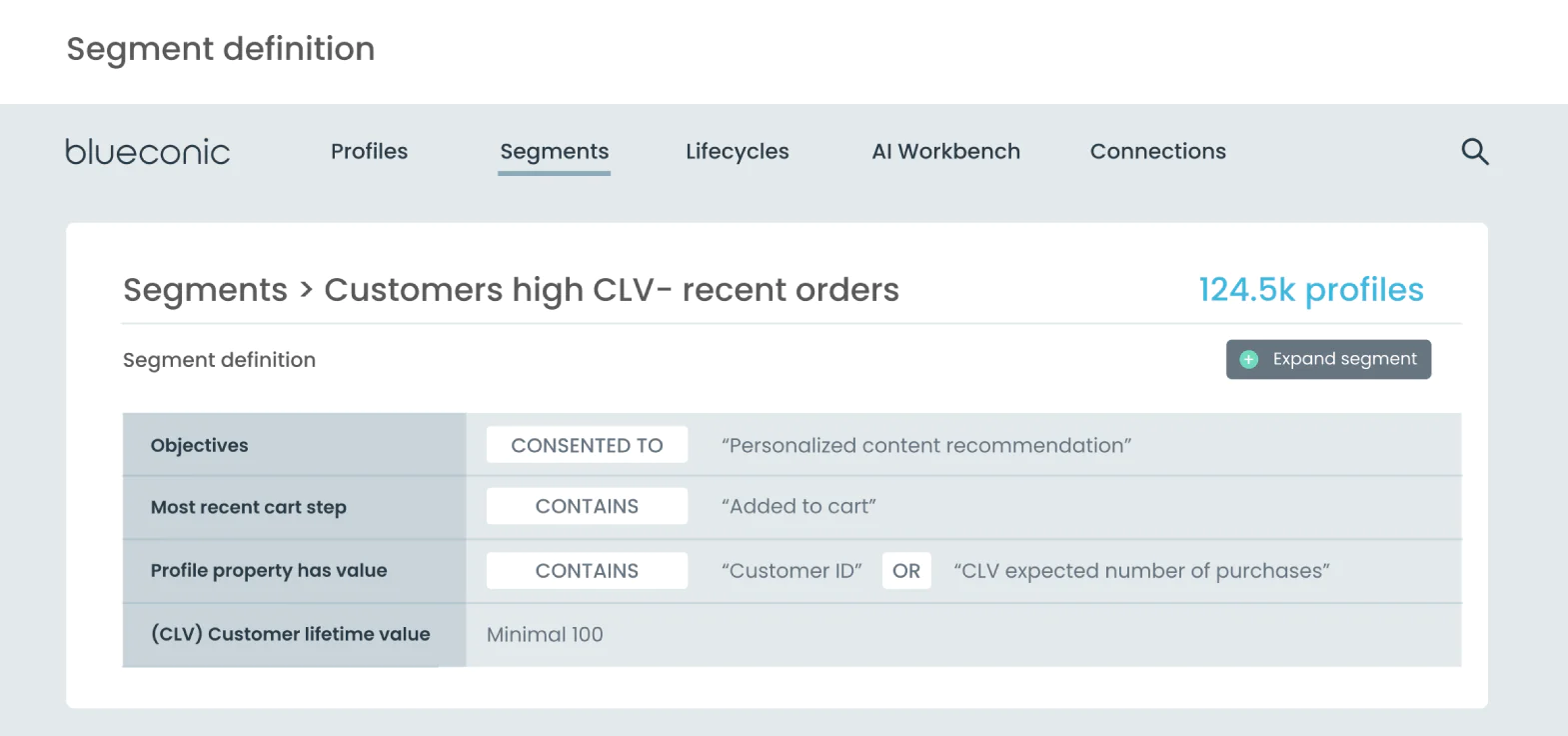
Blueconic’s segmentation
- Embedded personalization tools: BlueConic includes a lightweight content personalization engine. Users can create dialogues or recommendations on their site triggered by BlueConic in real time. While not as advanced as a dedicated personalization product, it covers many common needs and is directly fueled by the CDP data, which is powerful for quick wins (Tealium alone would require integrating a third-party personalization tool to do the same).
- Data syncing and openness: BlueConic emphasizes that marketers can access and use data freely—it’s not a black box. It provides easy export/import capabilities and an API. It may not handle the massive scale of ActionIQ or the complex transformations of mParticle, but for moderate scale and straightforward use cases it is very effective.
- Consent management and privacy: BlueConic has built-in consent management capabilities. It can serve consent dialogues (like cookie consent banners or marketing opt-in forms) and capture that consent status in profiles to ensure compliance in downstream messaging. This is a nice feature for GDPR/CCPA needs, letting you manage marketing permissions within the CDP and have that inform who gets targeted.
Strengths and Weaknesses
BlueConic’s strength is its usability and time-to-value for marketing. It’s often praised for deployments measured in days or weeks, not months. A marketing team can usually take ownership of BlueConic with minimal IT support—installing a tag or two (for web tracking) is most of the technical work; from there, the marketers can configure connectors, set up segments, etc. The interface is intuitive and tailored to marketing thinking (less about raw data tables, more about people and segments).

Blueconic’s analytics
Another strength is how it turns data into action quickly—the real-time profile updating means a user’s behavior instantly can qualify them for a segment that, say, triggers a website personalization or adds them to an email nurture track. The loop from data to action is very short. BlueConic often markets itself as enabling “moment marketing” where you can respond to user context immediately to drive conversions.
Also, BlueConic is vendor-neutral and flexible. It doesn’t force you into an ecosystem. You can use it just for data unification and send to all your existing tools (much like Tealium), or you can also use some of its built-in engagement features (like dialogues) if you don’t have others in place. For mid-sized companies that might not have budget for best-in-class every tool, BlueConic provides a lot in one (CDP + basic personalization + basic consent + connections to email, ads, etc.).
Because BlueConic aims for simplicity, it may not have all the advanced capabilities of more specialized or heavyweight solutions. For instance, its analytics capabilities are modest—you wouldn’t do multi-stage funnel analysis or complex joins in BlueConic (you’d do that in a BI tool or not at all). BlueConic expects you’ll bring data to it, use it to act, and if you need heavy analysis, you’ll export to somewhere else.
Scalability is another consideration. BlueConic can handle millions of profiles (many customers in publishing and retail with tens of millions of users use it successfully), but at an extreme Fortune-100 scale with hundreds of millions of profiles and petabytes of data, BlueConic might not be the first choice. BlueConic targets mid-market to upper mid-market primarily.
Also, BlueConic doesn’t do campaign orchestration across channels to the degree some others do. It can trigger certain things like on-site content or sync segments for emails, but it doesn’t have a journey builder sending multi-step communications on its own. In contrast, platforms like Maestra or Bloomreach have those multi-step journey capabilities in-house.
Another point: BlueConic’s out-of-the-box AI is present, but it’s not as hands-free as, say, Insider’s prebuilt AI segments or Bloomreach’s product recommendations. You might need someone with a bit of Python knowledge to create a really custom predictive model in BlueConic’s AI Workbench. It provides the environment, but you bring the model (they do have templates, though).
Compared to Tealium
BlueConic and Tealium both create unified profiles and sync data to other systems, but the experience of using them differs.
BlueConic is generally seen as more marketer-friendly day-to-day. The UI centers on profiles and dialogues with less need for understanding tag configurations or data layer mappings (Tealium’s initial setup requires data layer planning, etc.). Tealium, while user-friendly for those trained, often involves its own nomenclature (attributes, enrichments, connectors) which can have a learning curve.
Tealium doesn’t deliver messages itself; BlueConic can deliver on-site interactions. BlueConic can thus replace or supplement some front-end personalization that you’d otherwise need an Optimizely/Monetate or custom coding to do. If a quick win is, say, show a pop-up to users who meet X criteria, BlueConic does that natively, whereas Tealium would need to trigger a script or feed a personalization tool to achieve it.
Tealium iQ (tag manager) can ingest a very wide variety of web data and manage vendor tags—BlueConic’s web collection is mainly for its own purposes and is simpler. If you wanted to manage dozens of marketing/analytics tags across your site, BlueConic isn’t a tag manager; you’d still need one (maybe you’d still use GTM or another for that, or even Tealium iQ with BlueConic).
BlueConic is more focused on collecting user behavior for the profile and personalization, not deploying tags for third parties. So, if tag management is a part of your CDP initiative, Tealium covers that; BlueConic does not—it assumes you either don’t need a tag manager or you already have one.
Both do deterministic stitching (connecting known identifiers). Tealium AudienceStream and BlueConic have similar capabilities here, though Tealium might allow a bit more custom logic on how profiles merge/split. BlueConic keeps it straightforward (if these identifiers match, it’s same user). For most use cases, this is fine.
BlueConic is all about liberating data for marketers—it touts easy integration and export. Tealium, while also integrating, sometimes has upsells like you might need EventStream for some types of integration, etc. In BlueConic, connectors (integrations) are generally included (just limited by plan).
Choosing between them might come down to scale and enterprise needs vs agility and immediacy. An enterprise with lots of legacy systems and need for robust data processing might choose Tealium or even something bigger. A mid-sized company that just wants to start personalizing and unifying data quickly might choose BlueConic because it can be up and running fast and managed by a small team.
Compared to Maestra
BlueConic vs Maestra: BlueConic is only a CDP & basic personalization platform, not a full messaging platform, while Maestra is CDP + multi-channel messaging. If you need to send emails, SMS, etc., BlueConic will have to hand off data to another tool (e.g., send segment to Klaviyo or Mailchimp). Maestra can actually send those communications.
BlueConic is often used in tandem with existing tools (like it might feed Salesforce Marketing Cloud, and maybe control a bit of website personalization). Maestra tends to replace some of those existing tools.
Another difference: Loyalty and deeper CRM aspects—Maestra has that built-in. BlueConic can store loyalty info but has no dedicated loyalty management features (you’d integrate your loyalty program data into BlueConic, though). Also, Maestra has that promotions engine, which BlueConic doesn’t.
On AI and recommendations: BlueConic offers the AI workbench for custom models and some templates, but it might not be as plug-and-play as Maestra’s integrated AI triggers or product recs that are part of its offering. BlueConic’s philosophy is more “bring your own algorithm or use simple ones” whereas Maestra provides more pre-canned (especially tuned to e-commerce) AI capabilities.
For a marketing team that’s stretched thin and might not have a dedicated email team, Maestra bundling everything could relieve a lot of burden. For a marketing team that already has some execution muscle but needs better unified data and site personalization, BlueConic adds value without replacing everything they’ve built.
Final Thoughts
After reviewing these alternatives, it’s clear that the CDP and martech landscape in 2025 is rich with options. From data-first platforms like Segment, mParticle, and ActionIQ, to marketing powerhouses like Maestra, Insider, and Bloomreach, each comes with unique strengths. The choice ultimately depends on your business’s priorities, resources, and strategic vision.
When it comes to choosing the right tool to replace or augment Tealium, the decision ultimately hinges on your specific needs and ecosystem. But if you’re looking for a platform that does it all—and does it better—Maestra is the clear choice.
While some tools excel in specific areas—say, Segment for data pipelines or ActionIQ for analytics-driven segmentation—Maestra combines the best of these features into a seamless, unified solution.
Here’s how the competition stacks up in key areas:
- Data Integration vs. Activation: Pure CDPs like Segment and mParticle focus on collecting and routing, whereas Maestra not only unifies data but immediately activates it across channels (email, SMS, site, ads) from one place.
- Personalization & AI: Insider and Bloomreach are strong in personalization. Maestra matches their personalization prowess—from product recommendations to AI-driven triggers—while also blending in loyalty and promotions, which those platforms often require adding on.
- Omnichannel Reach: All the alternatives support multiple channels, but Maestra covers all major bases (email, SMS, push, web, ads) without requiring additional tools. Solutions like BlueConic excel at data and web personalization, but would need an external email system—Maestra has one built-in.
- Ease of Use vs. Flexibility: BlueConic and Insider are praised for marketer-friendliness, whereas ActionIQ and Tealium offer enterprise flexibility at the cost of more technical setup. Maestra strikes a balance: it’s designed for marketers to run with, yet robust enough (real-time, scalable) for enterprise demands.
- Supporting Infrastructure: Unlike some alternatives, Maestra provides white-glove service (a dedicated CSM) to ensure success. That’s akin to having an expert partner on call—something you won’t get with pure software solutions.
In short, Maestra differentiates itself by being more than just a CDP—it’s a full-service growth platform. It breaks down silos between your data and customer engagement, enabling hyper-personalized marketing that’s agile and cohesive in ways no patchwork of separate tools could be. Brands that choose Maestra aren’t simply adopting a new tool; they’re gaining a strategy accelerator that blends technology with hands-on expertise.
Ready to see the difference for yourself? Start with Maestra—Book a demo today and discover how it can revolutionize your customer data and engagement strategy for the year ahead.
